Cisco Systems SBSPA525G01 5-Line IP Phone User Manual
Cisco Systems Inc 5-Line IP Phone
Contents
- 1. User manual 1
- 2. User manual 2
- 3. Manual Part 1
- 4. Manual Part 2
User manual 1
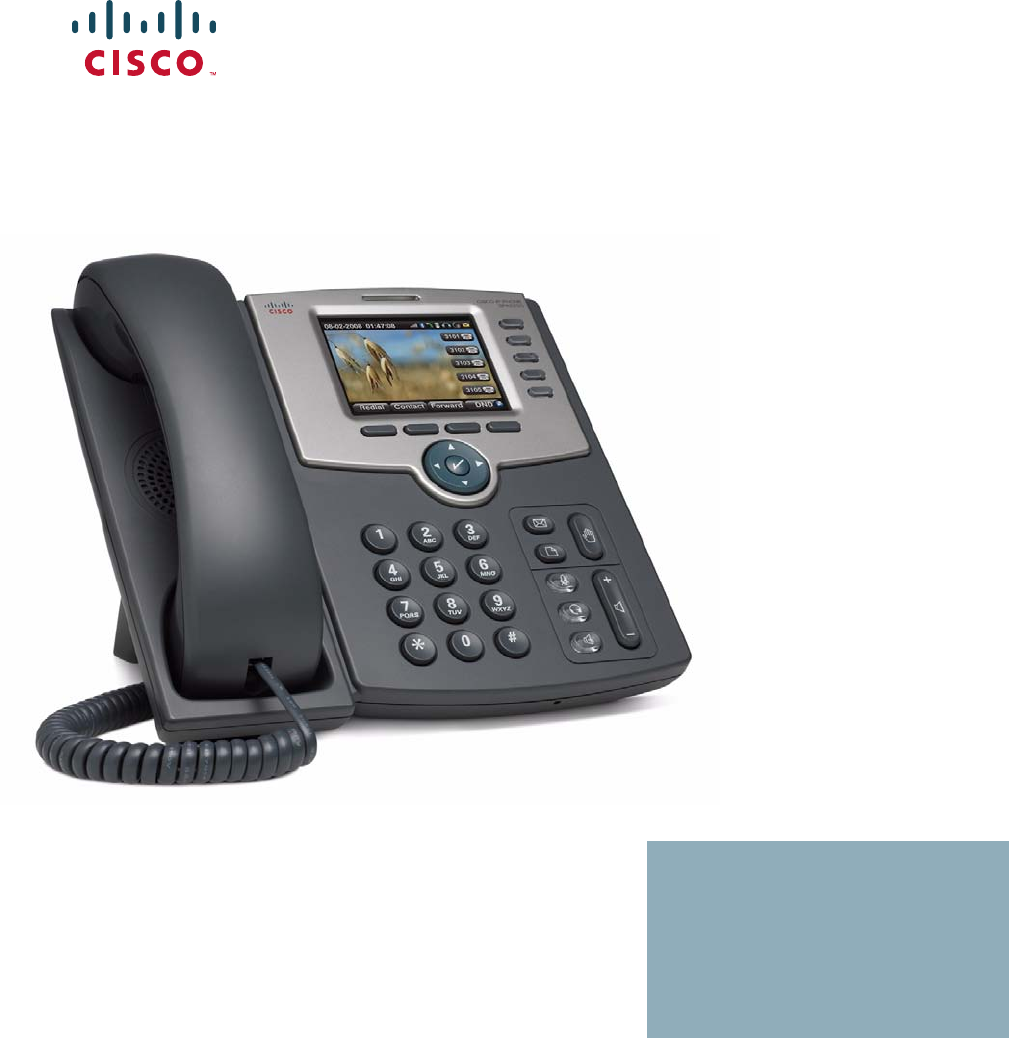
Cisco Small Business Pro
IP Phone Model SPA525G (SIP)
USER GUIDE

© 2008 Cisco Systems, Inc. All rights reserved. OL-18193-01
FCC and IC Statement
The availability of some specific channels and/or operational frequency bands are
country dependent and are firmware programmed at the factory to match the
intended destination. The firmware setting is not accessible by the end user.
Xd]VhbdgZi]Vc'%%d[[^XZhldgaYl^YZ#6YYgZhhZh!e]dcZcjbWZgh!VcY[VmcjbWZghVgZa^hiZYdci]Z8^hXdLZWh^iZVilll#X^hXd#Xdb$\d$d[[^XZh#
6bZg^XVh=ZVYfjVgiZgh
8^hXdHnhiZbh!>cX#
HVc?dhZ!86
6h^VEVX^[^X=ZVYfjVgiZgh
8^hXdHnhiZbhJH6EiZ#AiY#
H^c\VedgZ
:jgdeZ=ZVYfjVgiZgh
8^hXdHnhiZbh>ciZgcVi^dcVa7K
6bhiZgYVb!I]ZCZi]ZgaVcYh
8^hXd]VhbdgZi]Vc'%%d[[^XZhldgaYl^YZ#6YYgZhhZh!e]dcZcjbWZgh!VcY[VmcjbWZghVgZa^hiZYdci]Z8^hXdLZWh^iZVilll#X^hXd#Xdb$\d$d[[^XZh#
889:!88:CI!8^hXd:dh!8^hXdAjb^c!8^hXdCZmjh!8^hXdHiVY^jbK^h^dc!8^hXdIZaZEgZhZcXZ!8^hXdLZW:m!i]Z8^hXdad\d!98:!VcYLZaXdbZidi]Z=jbVcCZildg`VgZigVYZbVg`h08]Vc\^c\i]ZLVnLZLdg`!
6bZg^XVh=ZVYfjVgiZgh
8^hXdHnhiZbh!>cX#
HVc?dhZ!86
6h^VEVX^[^X=ZVYfjVgiZgh
8^hXdHnhiZbhJH6EiZ#AiY#
H^c\VedgZ
:jgdeZ=ZVYfjVgiZgh
8^hXdHnhiZbh>ciZgcVi^dcVa7K
6bhiZgYVb!I]ZCZi]ZgaVcYh
8^hXd]VhbdgZi]Vc'%%d[[^XZhldgaYl^YZ#6YYgZhhZh!e]dcZcjbWZgh!VcY[VmcjbWZghVgZa^hiZYdci]Z8^hXdLZWh^iZVilll#X^hXd#Xdb$\d$d[[^XZh#
889:!88:CI!8^hXd:dh!8^hXdAjb^c!8^hXdCZmjh!8^hXdHiVY^jbK^h^dc!8^hXdIZaZEgZhZcXZ!8^hXdLZW:m!i]Z8^hXdad\d!98:!VcYLZaXdbZidi]Z=jbVcCZildg`VgZigVYZbVg`h08]Vc\^c\i]ZLVnLZLdg`!
A^kZ!EaVn!VcYAZVgcVcY8^hXdHidgZVgZhZgk^XZbVg`h0VcY6XXZhhGZ\^higVg!6^gdcZi!6hncXDH!7g^c\^c\i]ZBZZi^c\IdNdj!8ViVanhi!8896!889E!88>:!88>E!88C6!88CE!88HE!88KE!8^hXd!i]Z8^hXd8Zgi^[^ZY
>ciZgcZildg`:meZgiad\d!8^hXd>DH!8^hXdEgZhh!8^hXdHnhiZbh!8^hXdHnhiZbh8Ve^iVa!i]Z8^hXdHnhiZbhad\d!8^hXdJc^in!8daaVWdgVi^dcL^i]djiA^b^iVi^dc!:i]Zg;Vhi!:i]ZgHl^iX]!:kZci8ZciZg!;VhiHiZe!;daadlBZ
7gdlh^c\!;dgbH]VgZ!<^\V9g^kZ!=dbZA^c`!>ciZgcZiFjdi^Zci!>DH!^E]dcZ!^Fj^X`HijYn!>gdcEdgi!i]Z>gdcEdgiad\d!A^\]iHigZVb!A^c`hnh!BZY^VIdcZ!BZZi^c\EaVXZ!BZZi^c\EaVXZ8]^bZHdjcY!B<M!CZildg`Zgh!CZildg`^c\
6XVYZbn!CZildg`GZ\^higVg!E8Cdl!E>M!EdlZgEVcZah!Egd8dccZXi!HXg^eiH]VgZ!HZcYZg7VhZ!HB6GIcZi!HeZXigjb:meZgi!HiVX`L^hZ!I]Z;VhiZhiLVnid>cXgZVhZNdjg>ciZgcZiFjdi^Zci!IgVchEVi]!LZW:m!VcYi]ZLZW:m
ad\dVgZgZ\^hiZgZYigVYZbVg`hd[8^hXdHnhiZbh!>cX#VcY$dg^ihV[[^a^ViZh^ci]ZJc^iZYHiViZhVcYXZgiV^cdi]ZgXdjcig^Zh#
6aadi]ZgigVYZbVg`hbZci^dcZY^ci]^hYdXjbZcidglZWh^iZVgZi]ZegdeZgind[i]Z^ggZheZXi^kZdlcZgh#I]ZjhZd[i]ZldgYeVgicZgYdZhcdi^beanVeVgicZgh]^egZaVi^dch]^eWZilZZc8^hXdVcYVcndi]ZgXdbeVcn#%-%.G
6bZg^XVh=ZVYfjVgiZgh
8^hXdHnhiZbh!>cX#
HVc?dhZ!86
6h^VEVX^[^X=ZVYfjVgiZgh
8^hXdHnhiZbhJH6EiZ#AiY#
H^c\VedgZ
:jgdeZ=ZVYfjVgiZgh
8^hXdHnhiZbh>ciZgcVi^dcVa7K
6bhiZgYVb!I]ZCZi]ZgaVcYh
Federal Communication Commission Interference Statement
This equipment has been tested and found to comply with the limits for a Class B digital device, pursuant to Part 15 of the FCC Rules.
These limits are designed to provide reasonable protection against harmful interference in a residential installation. This equipment
generates, uses and can radiate radio frequency energy and, if not installed and used in accordance with the instructions, may cause
harmful interference to radio communications. However, there is no guarantee that interference will not occur in a particular installation. If
this equipment does cause harmful interference to radio or television reception, which can be determined by turning the equipment off and
on, the user is encouraged to try to correct the interference by one of the following measures:
- Reorient or relocate the receiving antenna.
- Increase the separation between the equipment and receiver.
- Connect the equipment into an outlet on a circuit different from that
to which the receiver is connected.
- Consult the dealer or an experienced radio/TV technician for help.
FCC Caution: Any changes or modifications not expressly approved by the party responsible for compliance could void the user's authority
to operate this equipment.
This device complies with Part 15 of the FCC Rules. Operation is subject to the following two conditions: (1) This device may not cause
harmful interference, and (2) this device must accept any interference received, including interference that may cause undesired operation.
IMPORTANT NOTE:
FCC Radiation Exposure Statement:
This equipment complies with FCC radiation exposure limits set forth for an uncontrolled environment. This equipment should be installed
and operated with minimum distance 20cm between the radiator & your body.
This transmitter must not be co-located or operating in conjunction with any other antenna or transmitter.
Industry Canada statement:
This device complies with RSS-210 of the Industry Canada Rules. Operation is subject to the following two conditions:
(1) This device may not cause harmful interference, and (2) this device must accept any interference received, including interference that
may cause undesired operation.
IMPORTANT NOTE:
Radiation Exposure Statement:
This equipment complies with IC radiation exposure limits set forth for an uncontrolled environment. This equipment should be installed
and operated with minimum distance 20cm between the radiator & your body.

Contents
Cisco Small Business Pro SPA IP Phone 525G (SIP) User Guide 1
FCC and IC Statement 2
9
Chapter 1: Getting Started 10
Overview of the Cisco SPA525G IP Phone 11
Caring for Your Phone 12
Understanding Your Phone’s Lines and Buttons 13
Phone Components 13
Softkey Buttons 15
Using the Keypad and Buttons with Menus 18
Using Keypad Shortcuts 18
Using the Navigation Button 18
Entering Numbers and Text in Fields 19
Using Phone Hardware and Accessories 20
Using the Speakerphone 20
Using Wired and Wireless Headsets 20
Connecting the Headset 20
Connecting Bluetooth Headsets 21
Using a Headset with Your IP Phone 22
Switching Between the Handset/Headset/Speakerphone
During a Call 22
Chapter 2: Installing Your Phone 24
Before You Begin 25
Connecting the Handset 25
(Optional) Attaching the Desk Stand 27
(Optional) Mounting the Phone to the Wall 28
Connecting Your Phone’s Power 30

Contents
Cisco Small Business Pro SPA IP Phone 525G (SIP) User Guide 2
Connecting Your Phone to the Computer Network 31
Connecting Your Phone to the Wired Network 31
Connecting Your Phone to the Wireless Network 31
Determining Your Wireless Router Security Type 32
Using Wi-Fi Protected Setup with the SPA525G 35
Manually Adding a Wireless Profile on the SPA525G 36
Uploading Security Certificates to the Phone 38
Verifying Phone Startup 39
Upgrading Your Phone’s Firmware 39
Chapter 3: Using Basic Phone Functions 41
Placing or Answering a Call 42
Using Dial Assistance 43
Adjusting Call Volume and Muting 43
Adjusting Call Volume 43
Using Mute 43
Putting a Call on Hold 43
Resuming a Call 44
Ending a Call 44
Transferring Calls 44
Performing an Attended Transfer 44
Performing an Unattended (Blind) Transfer 45
Redialing 45
Viewing and Returning Missed Calls 46
Returning a Missed Call 46
Viewing a List of Missed Calls 46
Turning the Missed Calls Shortcut On and Off 47

Contents
Cisco Small Business Pro SPA IP Phone 525G (SIP) User Guide 3
Forwarding Calls 47
Forwarding Calls to a Single Number 48
Forwarding Calls When Your Phone is Busy 48
Forwarding Calls When You Don’t Answer the Phone 49
Delaying Call Forwarding When You Don’t Answer the Phone 49
Stopping Call Forwarding 49
Setting Do Not Disturb 49
Configuring Call Waiting 50
Picking Up a Call 51
Parking a Call 52
Placing a Three-Way Conference Call 53
Using the Phone Directories 54
Using Your Personal Address Book 54
Adding a New Contact 55
Copying a Contact 56
Searching for a Contact 56
Deleting a Contact 56
Editing a Contact 57
Using the Corporate Directory 57
Using the Call History Lists 58
Viewing the Call History Lists 58
Deleting a Call History List 59
Calling from the Call History Lists 59
Deleting an Entry from the Call History Lists 59
Saving a Call History List Number to Your Directory 60
Setting or Changing a Phone Password 60
Logging In and Logging Out of Your Phone 61
Accessing Voicemail 61

Contents
Cisco Small Business Pro SPA IP Phone 525G (SIP) User Guide 4
Chapter 4: Using Advanced Phone Features 63
Configuring Privacy and Security Features 64
Blocking Caller ID 64
Blocking Anonymous Calls 64
Using Secure Call 65
Enabling Dial Assistance 65
Creating and Using Speed Dials 66
Playing MP3 Files on Your Phone 67
Creating the Playlist 67
Playing Songs 68
Changing the Left and Right Channel for Stereo Headsets 69
Using the Paging Feature 69
Paging Another Phone 69
Configuring Auto Answer 70
Customizing Your LCD Screen 70
Changing the LCD Screen Contrast 70
Setting the Screen Backlight Timer 71
Configuring the Phone Screen Saver 71
Changing the Phone Wallpaper 72
Using Ring Tones 73
Accessing Weather and News on Your Phone 74
Accessing Weather Information 74
Accessing News 75
Configuring Date and Time Parameters on Your Phone 76
Using Star Codes 77
Restarting Your Phone 79
Viewing Phone, Network, and Call Information 79
Viewing Phone Information 79
Viewing Network Information 80
Viewing Phone Line and Extension Information 80
Viewing Peripheral Status 81

Contents
Cisco Small Business Pro SPA IP Phone 525G (SIP) User Guide 5
Viewing the Wireless Connection Status 81
Advanced Menus for Technical Support Personnel 82
Chapter 5: Using the Web Interface 83
Logging in to the Web Interface 84
Configuring Your Address Book 84
Setting Do Not Disturb 85
Configuring Call Forwarding 86
Configuring Call Waiting 87
Blocking Caller ID 87
Blocking Anonymous Calls 88
Viewing Call History Lists 88
Creating Speed Dials 89
Configuring Wi-Fi 89
Configuring Bluetooth 90
Upgrading Firmware 91
Chapter 6: Using the SPA932 Attendant Console 92
Connecting the SPA932 Attendant Console to the
SPA525G IP Phone 93
Connecting a Single SPA932 93
Connecting an Additional SPA932 97
Using the SPA932 Attendant Console with Your
SPA525G IP Phone 98
Monitoring the SPA932 99
Appendix A: Additional Information 100
Regulatory Compliance and Safety Information 100
Warranty 100
End User License Agreement (EULA) 100
Support Contacts 100

Contents
Cisco Small Business Pro SPA IP Phone 525G (SIP) User Guide 6
Appendix B: Where to Go From Here 101
Related Documentation 102
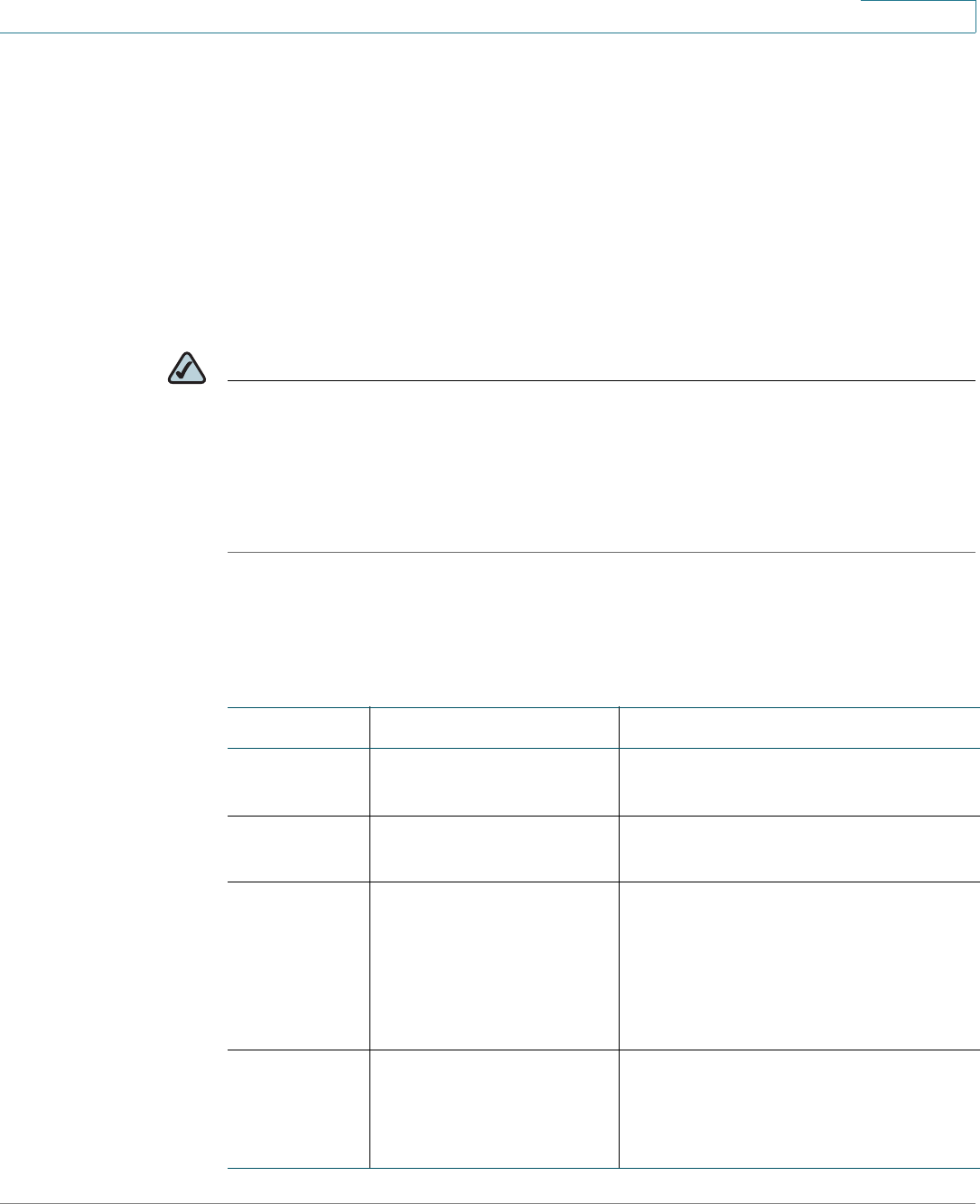
Preface
Cisco Small Business Pro SPA525G (SIP) User Guide 6
About This Document
Purpose
This guide describes the concepts and tasks necessary to use and configure your
Cisco SPA525G IP Phone.
NOTE The SPA525G features vary, depending on the type of call control system that you
are using. This document describes using the SPA525G with a SIP phone system,
such as the Cisco SPA9000 Voice System or a Broadsoft or Asterisk system. If you
are using the SPA525G with a Cisco Unified Communications 500 Series, see the
Cisco Unified Communications Manager Express for Cisco Unified IP Phone 525G
User Guide
.
Organization
This table describes the contents of each chapter in this document.
Chapter Title Description
Chapter 1 Getting Started Provides an overview of the
SPA525G IP phone.
Chapter 2 Installing Your Phone Connecting your hardware and the
SPA525G phone to the network.
Chapter 3 Using Basic Phone
Functions
Performing basic phone functions,
such as making, transferring,
forwarding, and parking calls,
creating conference calls, and using
the phone directory and call history
lists.
Chapter 4 Using Advanced Phone
Features
Configuring advanced features on
your phone, such as privacy and
security features, speed dials, and
ring tones.
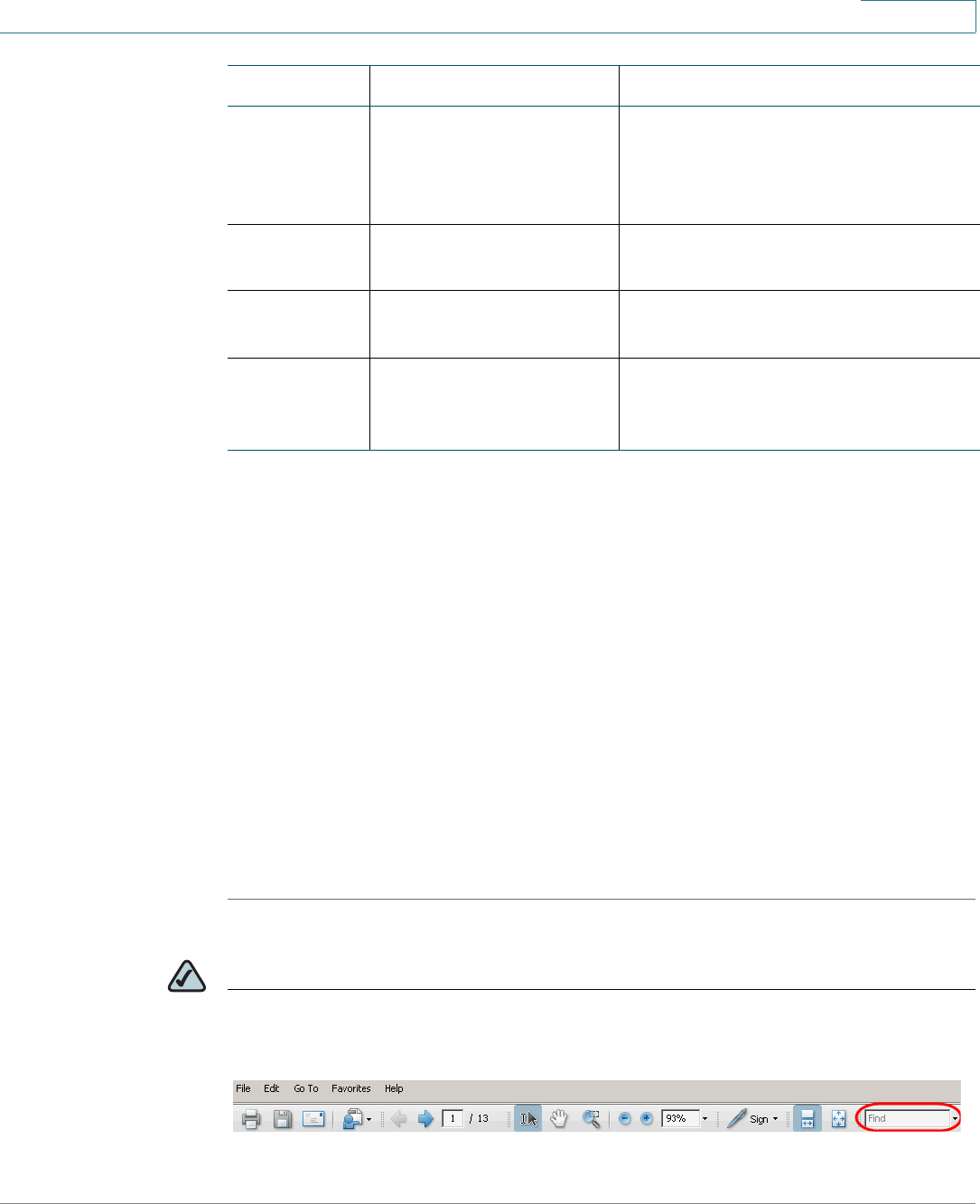
Preface
Cisco Small Business Pro SPA525G (SIP) User Guide 7
Finding Information in PDF Files
The <Product Name> documents are published as PDF files. The PDF Find/Search
tool within Adobe® Reader® lets you find information quickly and easily online.
You can perform the following tasks:
•Search an individual PDF file.
•Search multiple PDF files at once (for example, all PDFs in a specific folder
or disk drive).
•Perform advanced searches.
Finding Text in a PDF
Follow this procedure to find text in a PDF file.
STEP 1 Enter your search terms in the Find text box on the toolbar.
NOTE By default, the Find tool is available at the right end of the Acrobat toolbar. If the
Find tool does not appear, choose Edit > Find.
Chapter 5 Using the Web Interface Accessing the web user interface for
your phone to configure your
address book, speed dials, and other
phone features.
Chapter 6 Using the SPA932
Attendant Console
Installing and using the SPA932
Attendant Console.
Appendix A Additional Information Additional information for your
product.
Appendix B Where to Go From Here Provides URLs for related product
documentation and resources
available on Cisco.com.
Chapter Title Description
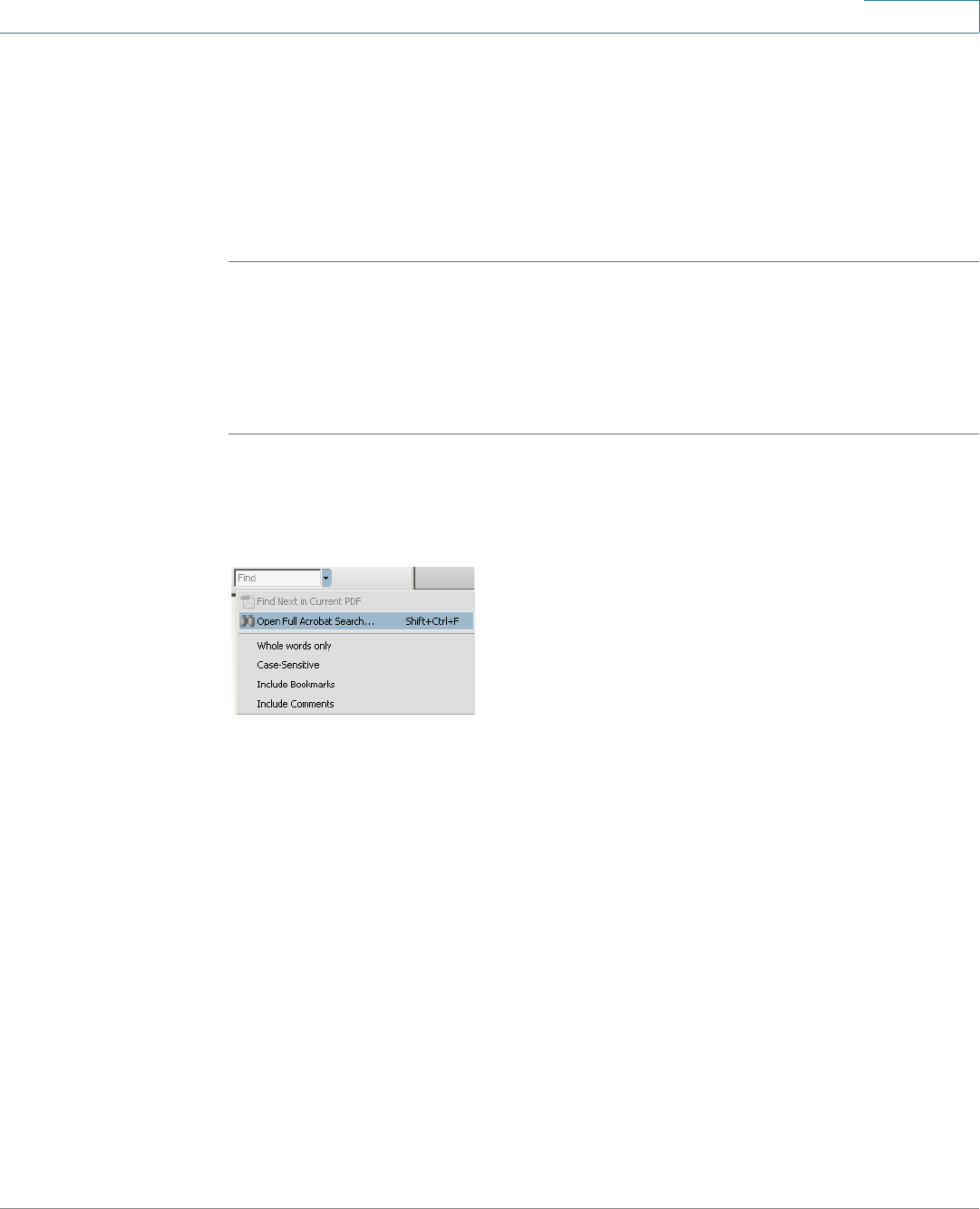
Preface
Cisco Small Business Pro SPA525G (SIP) User Guide 8
STEP 2 Optionally, click the arrow next to the Find text box to refine your search by
choosing special options such as Whole Words Only.
STEP 3 Press Enter.
STEP 4 Acrobat displays the first instance of the search term.
STEP 5 Press Enter again to continue to more instances of the term.
Finding Text in Multiple PDF Files
The
Search
window lets you search for terms in multiple PDF files that are stored
on your PC or local network. The PDF files do not need to be open.
STEP 1 Start Acrobat Professional or Adobe Reader.
STEP 2 Choose Edit > Search, or click the arrow next to the
Find
box and then choose
Open Full Acrobat Search.
STEP 3 In the
Search
window, complete the following steps:
a. Enter the text that you want to find.
b. Choose All PDF Documents in.
From the drop-down box, choose Browse for Location. Then choose the
location on your computer or local network, and click OK.
c. If you want to specify additional search criteria, click Use Advanced Search
Options, and choose the options you want.
d. Click Search.
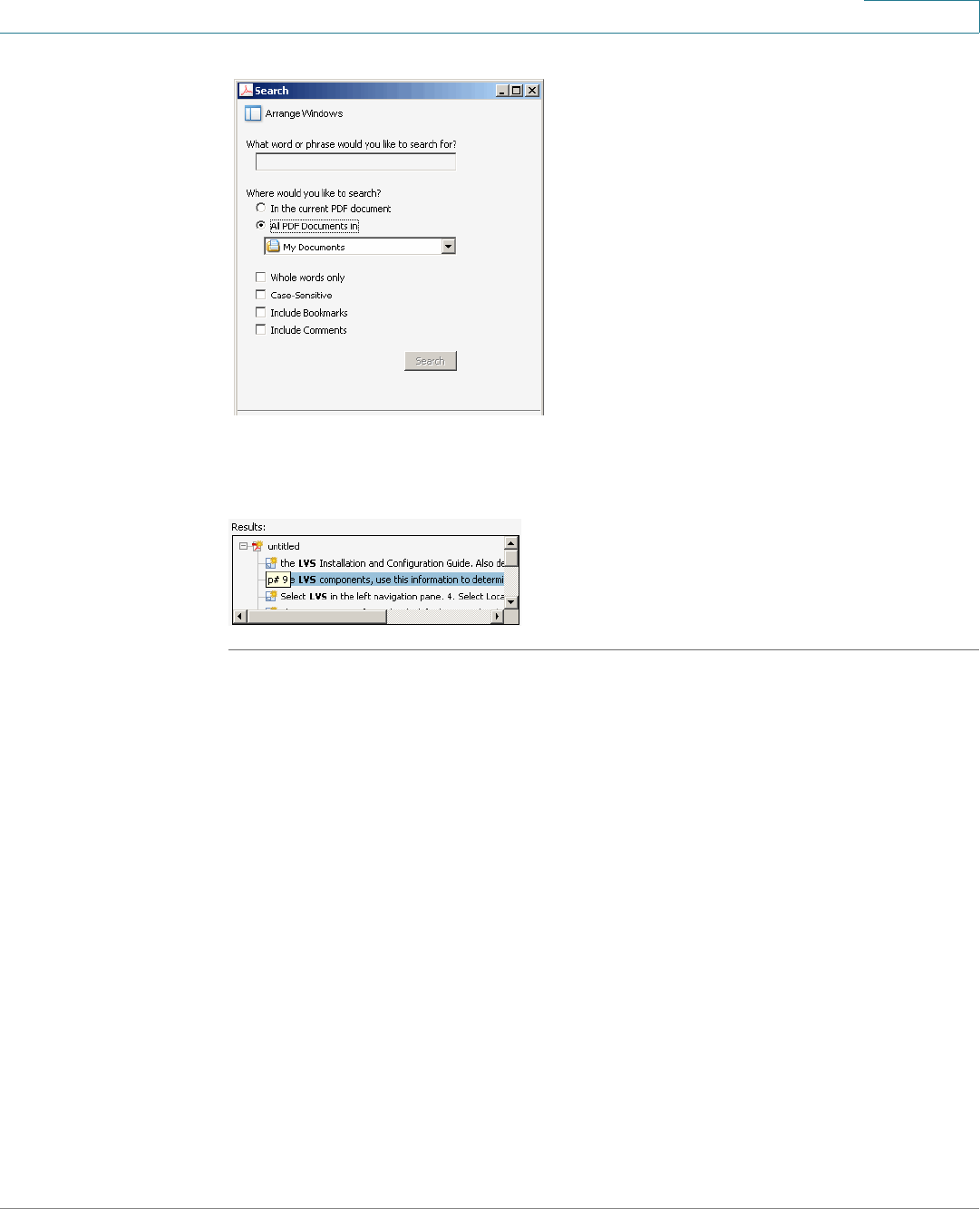
Preface
Cisco Small Business Pro SPA525G (SIP) User Guide 9
STEP 4 When the Results appear, click + to open a folder, and then click any link to open
the file where the search terms appear.
For more information about the Find and Search functions, see the Adobe Acrobat
online help.
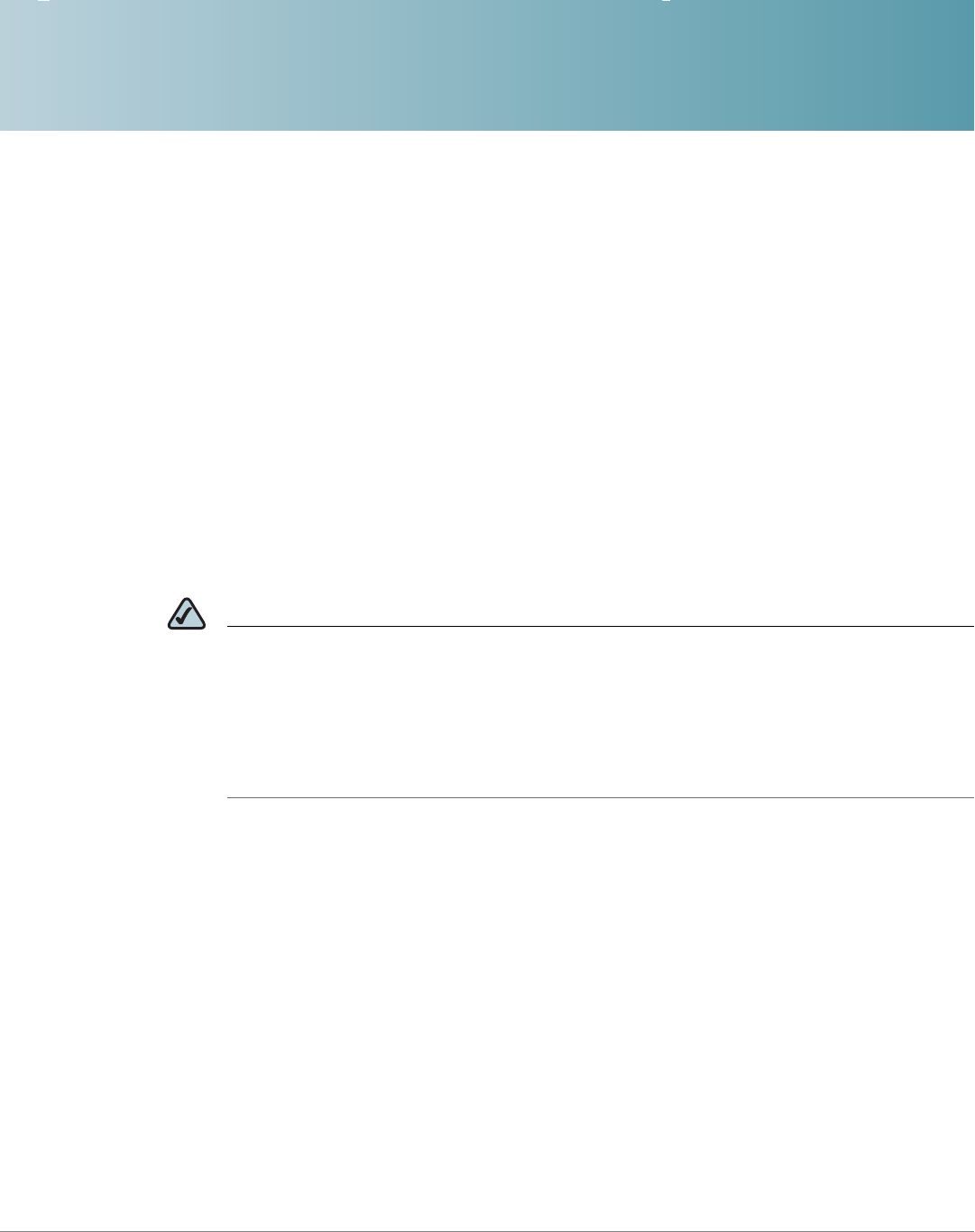
1
Cisco Small Business Pro SPA IP Phone 525G (SIP) User Guide 10
Getting Started
This chapter provides an overview of your SPA525G IP phone. contains the
following sections:
•Overview of the Cisco SPA525G IP Phone, page11
•Understanding Your Phone’s Lines and Buttons, page13
•Using the Keypad and Buttons with Menus, page18
•Entering Numbers and Text in Fields, page19
•Using Phone Hardware and Accessories, page 20
NOTE The SPA525G features vary, depending on the type of call control system you are
using. This document describes using the SPA525G with a SIP phone system, such
as the Cisco SPA9000 Voice System or a Broadsoft or Asterisk system. If you are
using the SPA525G with a Cisco Unified Communications 500 Series, see the
Cisco Unified Communications Manager Express for Cisco Unified IP Phone 525G
User Guide
.
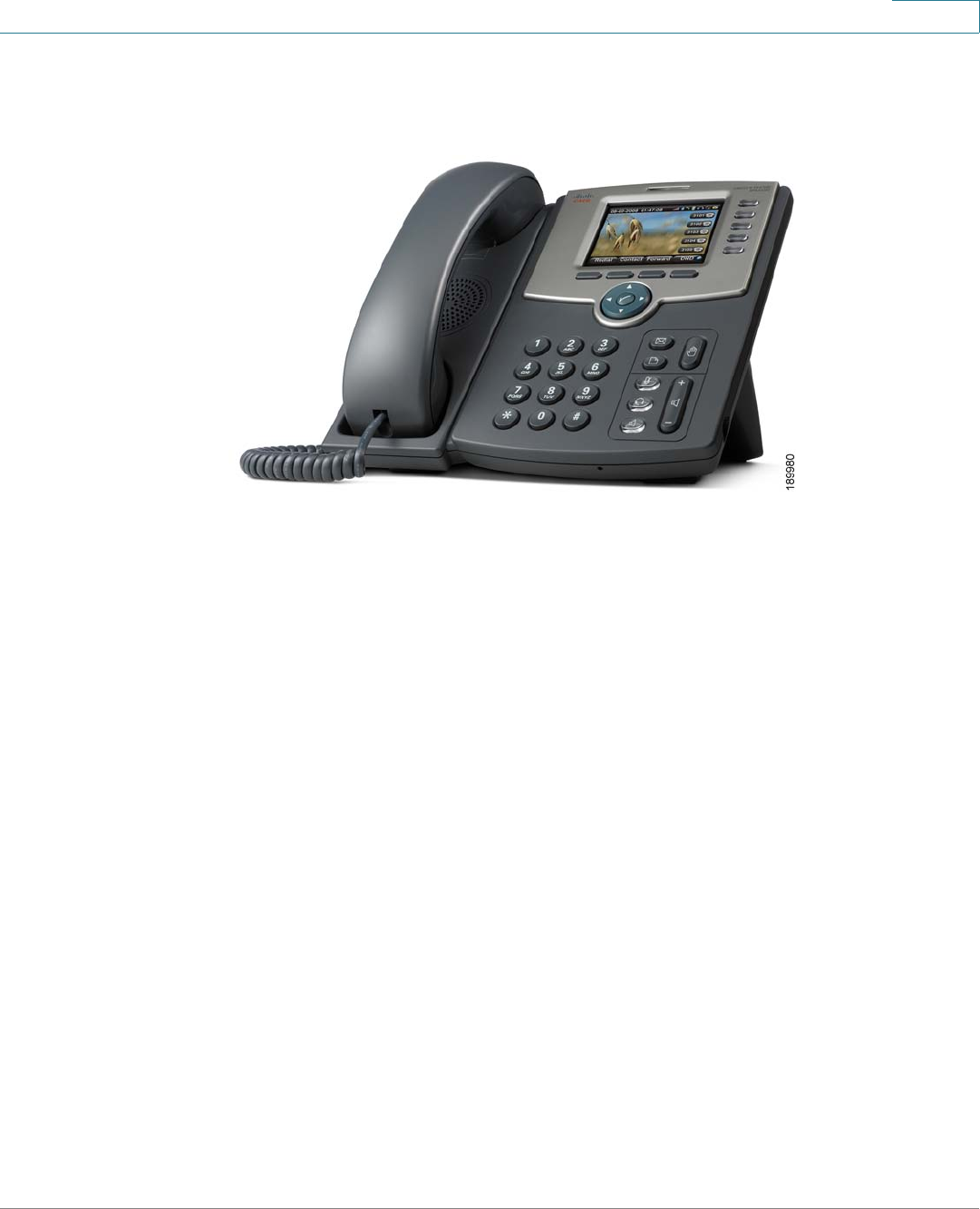
Getting Started
Overview of the Cisco SPA525G IP Phone
Cisco Small Business Pro SPA IP Phone 525G (SIP) User Guide 11
1
Overview of the Cisco SPA525G IP Phone
The Cisco SPA525G IP Phone is a full-featured VoIP (Voice over Internet Protocol)
phone that provide voice communication over an IP network. It provides traditional
features, such as call forwarding, redialing, speed dialing, transferring calls,
conference calling and accessing voice mail. Calls can be made or received with a
handset, headset or speaker.
The SPA525G phone is connected to the network through its Ethernet connection
or the built-in Wireless-G connection. If you are using the Wireless-G connection, a
separate power adapter (PA-100) is required. The SPA525G provides an additional
Ethernet port that allows a computer to be connected to the network through the
IP phone. (This option is only available when phone is connected to the network
via the wired Ethernet connection).
Unlike traditional phones, the Cisco SPA525G requires a separate power source.
Either connect your phone to an Ethernet switch that provides Power over Ethernet
(PoE), or use a separate power adapter (PA-100).

Getting Started
Overview of the Cisco SPA525G IP Phone
Cisco Small Business Pro SPA IP Phone 525G (SIP) User Guide 12
1
The SPA525G has a 320 x 240 color, 3.2" inch LCD screen and provides up to five
telephone extensions. It provides the following hardware features:
•2 Ethernet 10/100 Mbps ports
•802.3af Power over Ethernet support
•USB 2.0 host port for connecting a USB memory device to play MP3 music
files
•AUX port (to attach a SPA932 attendant console)
•Bluetooth capability for headset support
•2.5mm stereo earphone jack for headset
•Wireless-G client support
•Kensington security slot support
Caring for Your Phone
The Cisco Small Business Pro IP phones are electronic devices that should not be
exposed to excessive heat, sun, cold or water. To clean the equipment, use a
slightly moistened paper or cloth towel. Do not spray or pour cleaning solution
directly onto the hardware unit.
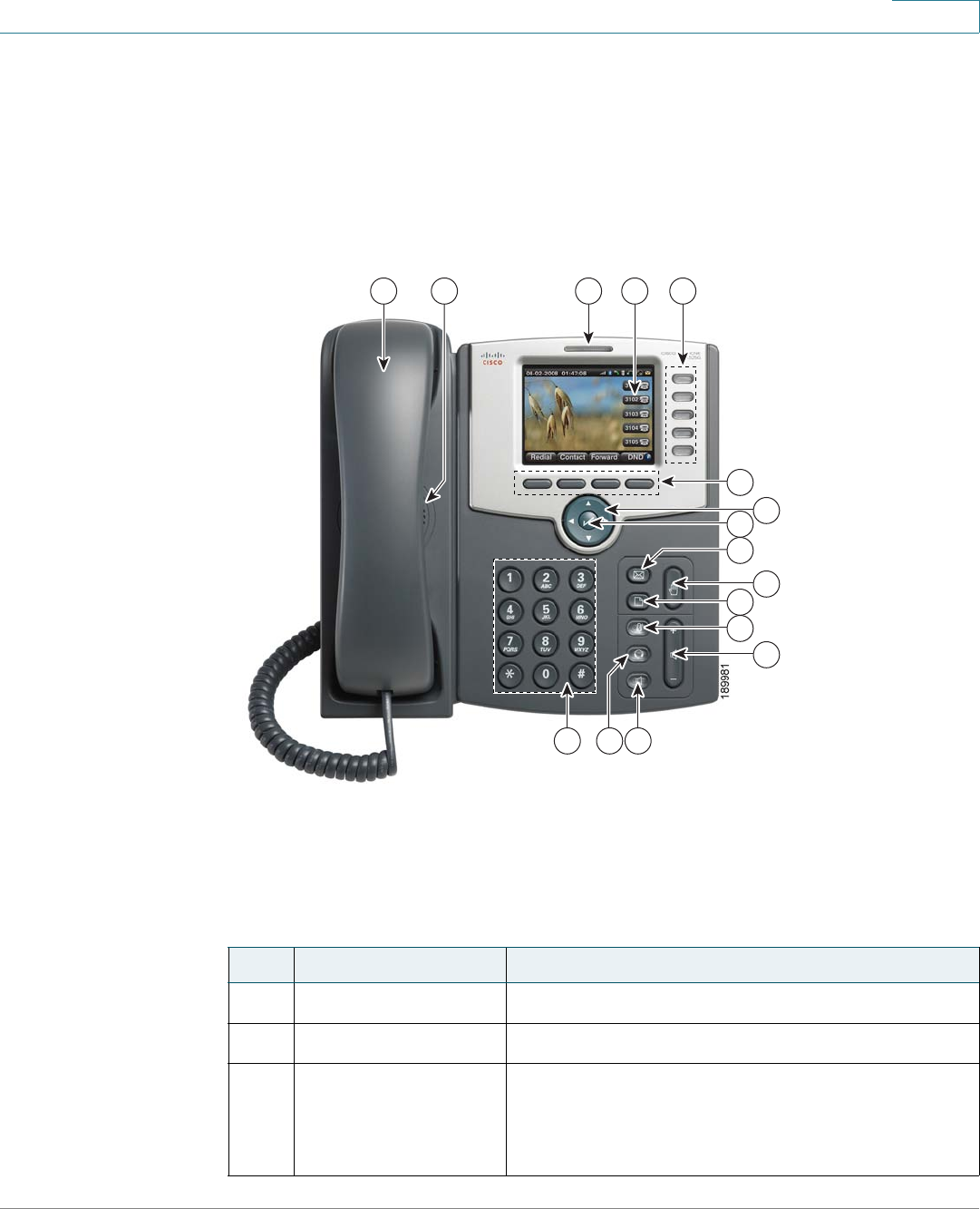
Getting Started
Understanding Your Phone’s Lines and Buttons
Cisco Small Business Pro SPA IP Phone 525G (SIP) User Guide 13
1
Understanding Your Phone’s Lines and Buttons
Use the following graphic and table to identify the parts of your phone.
Phone Components
Figure 1 SPA525G Phone Components
Table 1 IP Phone Components
#Phone Feature Description
1 Handset Pick up to answer or place calls.
2 Speaker Speaker for phone.
3 Message Waiting
Indicator
When lit:
•Red—You have a new voice mail message.
•Flashing Red—You have an incoming call.
1 2 3 54
14
6
10
13
11
12
9
7
8
1516

Getting Started
Understanding Your Phone’s Lines and Buttons
Cisco Small Business Pro SPA IP Phone 525G (SIP) User Guide 14
1
4 LCD Screen Your phone may vary, but typically displays:
•Date and time
•Phone station name
•Line extensions
•Softkey options
•Startup logo, screen saver, background photo, and
photo album
5 Line keys Indicates phone line status. Your phone may vary, but
typically, when lit:
•Green: Line is idle.
•Red (steady): Line is active or in use.
•Red (blinking): Line is on hold.
•Orange: Line is unregistered (cannot be used).
•Flashing Orange: The phone is not connected to
the network.
6 Softkey buttons Press a softkey button to perform the action on the
label on the LCD screen above.
7 Navigation button Press in each direction to scroll through items on the
LCD screen.
8 Center Select button Press this button to select the option or menu that is
highlighted on the screen.
9 Messages button Press to access voice mail (must be set up by your
phone administrator).
10 Hold button Press to place a call on hold.
11 Setup button Press to access the phone’s configuration menu to
configure features and preferences (such as your
directory and speed dials), access your call history,
and set up functions (such as call forwarding).
12 Mute button Press to mute or unmute the phone. When the phone is
muted, the button glows red. A flashing red mute
button indicates that the phone has no network
connectivity.
Table 1 IP Phone Components
#Phone Feature Description
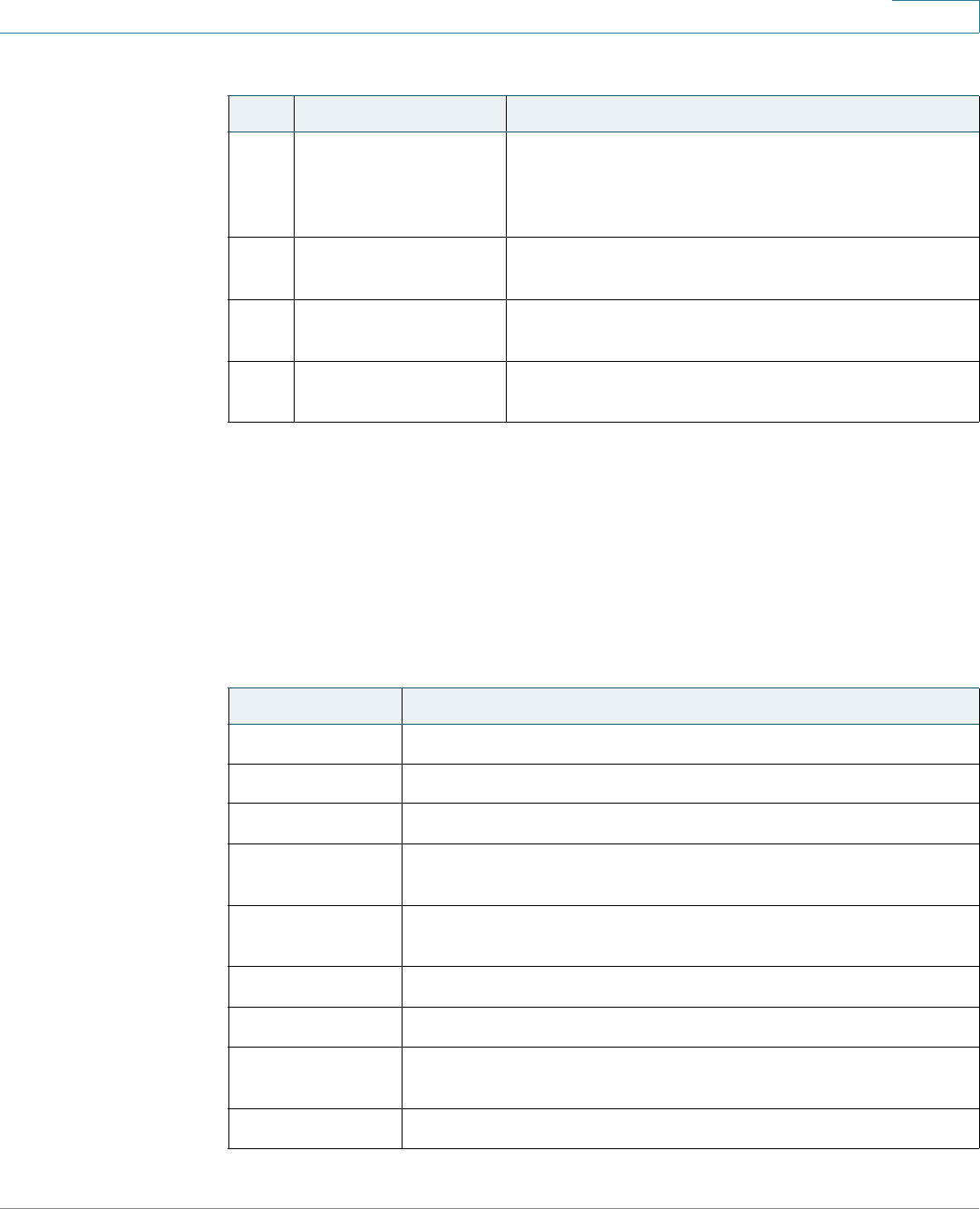
Getting Started
Understanding Your Phone’s Lines and Buttons
Cisco Small Business Pro SPA IP Phone 525G (SIP) User Guide 15
1
Softkey Buttons
The four softkey buttons have different functions depending on the phone screen
or menu that is shown. The following table shows the SPA525G softkey buttons
that are available (in alphabetical order).
13 Volume button Press + to increase the volume and press - to lower
the volume of the handset, headset, speaker (when
the handset is off hook), or ringer (when the handset is
on hook).
14 Headset button Press to turn the headset on or off. When the headset
is on, the button glows green.
15 Speaker button Press to turn the speaker on or off. When the speaker
is on, the button glows green.
16 Keypad Press keys to dial phone numbers, enter letters, and
choose menu items.
Table 2 SPA525G Softkey Buttons
Button Function
Add Adds a new item (for example, a new directory entry).
AddList Creates a list (for example, of MP3 files to play).
Back Returns you to the previous screen.
BXfer Performs a blind call transfer. See “Performing an Unattended
(Blind) Transfer,” on page 45.
Call Rtn Returns the last missed call by dialing the number that called you.
See “Viewing and Returning Missed Calls,” on page 46.
Clear Deletes an entire text/number field.
Clr DND Clears Do Not Disturb.
Conf Initiates a conference call. See “Placing a Three-Way Conference
Call,” on page 53.
ConfLx Conferences existing active calls on the phone together.
Table 1 IP Phone Components
#Phone Feature Description

Getting Started
Understanding Your Phone’s Lines and Buttons
Cisco Small Business Pro SPA IP Phone 525G (SIP) User Guide 16
1
Connect Connects to the selected item (for example, to the wireless
network or Bluetooth device).
Copy Copies the selected item (for example, a contact in the Address
Book).
delChar Deletes the last number or letter.
Delete Deletes an entire item (for example, a number from the Call History
list).
Dial Dials the string of numbers that you have entered, or the number
that you have highlighted in a list such as the Missed Calls screen.
Directory Access your personal address book. See “Using Your Personal
Address Book,” on page 54.
DND Do Not Disturb; prevents incoming calls from ringing your phone.
See “Setting Do Not Disturb,” on page 49.
Edit Opens an item so that you can edit numbers or letters, or enable or
disable a feature.
EditDial Edits a number before dialing.
End Call Disconnects a call.
Forward Forwards calls coming to your phone. See “Forwarding Calls,” on
page 47.
List In some menus, shows a list of configured items (for example, a list
of locations for weather or news).
GrPickup Allows you to pick up (answer) a call at that is ringing at another
extension in your group. See “Picking Up a Call,” on page 51.
Hold Places a call on hold. See “Putting a Call on Hold,” on page 43.
More Access additional softkeys.
Next Moves to the next item in a list (for example, a song in the MP3
Playlist).
Option Enters a sub-menu.
Paste Pastes the item you copied into a list or field.
Pickup Allows you to pick up (answer) a call that is ringing at another
extension. See “Picking Up a Call,” on page 51.
Table 2 SPA525G Softkey Buttons
Button Function

Getting Started
Understanding Your Phone’s Lines and Buttons
Cisco Small Business Pro SPA IP Phone 525G (SIP) User Guide 17
1
Play Plays a selected item such as a song or a ringtone.
Previous Moves to a previous item in a list (for example, a song in the MP3
Playlist).
Redial Brings up the list of recently dialed numbers. See “Redialing,” on
page 45.
Refresh Refreshes the screen. Useful after changing a configuration or
when you want to update information (such as weather).
Park Parks a call at a designated “park” number. The call is active until
you unpark it, or the caller disconnects. See “Parking a Call,” on
page 52.
Play Plays an item (for example, a ring tone).
Resume Resumes a call that is on hold.
Save Saves your changes.
Scan Scans for wireless networks or Bluetooth devices.
Select Selects the highlighted item on the LCD screen.
Transfer Performs a call transfer. See “Transferring Calls,” on page 44.
Unpark Connects to a parked call. See “Parking a Call,” on page 52.
View Displays more information about a selected item.
XferLX Transfers existing active calls on the phone.
Table 2 SPA525G Softkey Buttons
Button Function
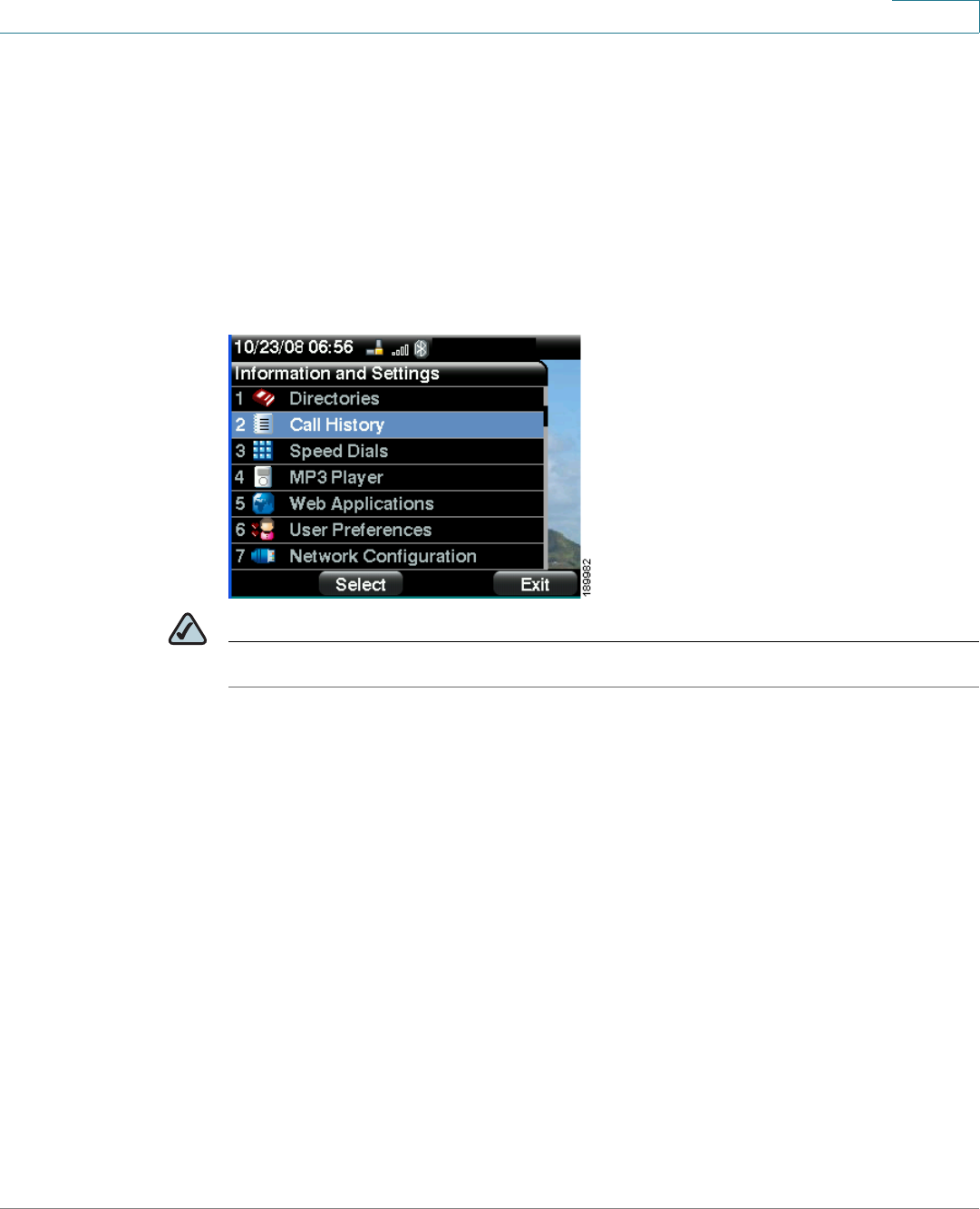
Getting Started
Using the Keypad and Buttons with Menus
Cisco Small Business Pro SPA IP Phone 525G (SIP) User Guide 18
1
Using the Keypad and Buttons with Menus
You press a softkey button or other buttons to enter menus on the LCD screen.
Using Keypad Shortcuts
Use the keypad to enter the number of the menu or sub-menu item. For example,
to reach the Call History menu, press the Setup button and press 2.
NOTE Menus and options can change depending on the software release.
Using the Navigation Button
Use the navigation button to scroll up or down through the menu items, and then
press the Select softkey button or the center Select button to choose the
highlighted item.

Getting Started
Entering Numbers and Text in Fields
Cisco Small Business Pro SPA IP Phone 525G (SIP) User Guide 19
1
Entering Numbers and Text in Fields
Some fields on the IP phones require you to enter numbers and text using the
keypad and/or softkey buttons. In general, the following guidelines apply:
•Use the keypad to enter numbers and characters, pressing the key multiple
times to select the correct number or letter.
•Press the number key multiple times to move to a different letter under that
number. (For example, to enter “Mary,” you would press 6 five times rapidly
and then pause (for M); press 2 and then pause (for A), press 7 three times
rapidly (for r), then press 9 three times rapidly (for y).
Available characters are shown in the following table:
Use the delChar softkey button to backspace and delete the last character.
Use the Option > Clear softkey button to remove the entire entry.
Key Character Set
1 1 / : \ , ! ; $ ^ |
2abc2ABC
3def3DEF
4ghi4GHI
5jkl5JKL
6mno6MNO
7pqrs7PQRS
8tuv8TUV
9wxyz9WXYZ
0 Space 0 ~ ? > ‘ < “
* . @ * & % [ ] _
#/P # + - = ( ) { }

Getting Started
Using Phone Hardware and Accessories
Cisco Small Business Pro SPA IP Phone 525G (SIP) User Guide 20
1
Using Phone Hardware and Accessories
Using the Speakerphone
The SPA IP Phones provide a speakerphone. To use the speakerphone, press the
Speaker button (the handset can be either on or off hook).
Using Wired and Wireless Headsets
The SPA IP Phones support headsets from different manufacturers. For the latest
supported models, contact your reseller. Additional information can be found at
the manufacturer’s websites:
http://www.plantronics.com
http://www.jabra.com
Connecting the Headset
Each brand and type of headset may require different steps for connection.
Consult the documentation for your particular headset for more information. In
general, to connect a headset:
•For Bluetooth headsets: See the ”Connecting Bluetooth Headsets” section on
page 21.
•For wireless, non-Bluetooth headsets (such as Plantronics or Jabra): Connect
the headset’s telephone cord into the telephone port on the back of the SPA IP
Phone.
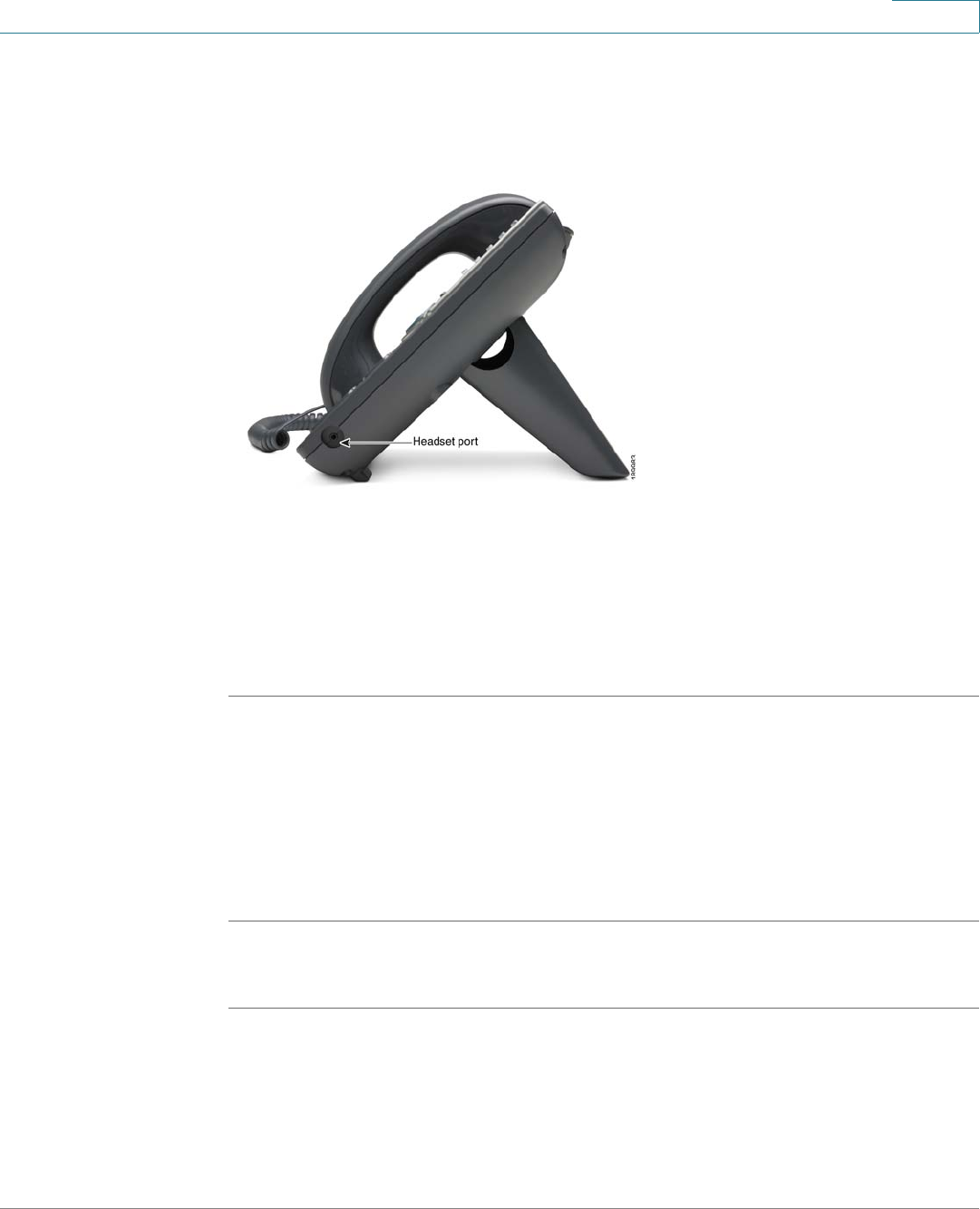
Getting Started
Using Phone Hardware and Accessories
Cisco Small Business Pro SPA IP Phone 525G (SIP) User Guide 21
1
•For wired headsets: Connect the 2.5mm connector from the headset into the
headset port on the right side of the IP phone as shown in the following
graphic:
Connecting Bluetooth Headsets
Your phone is Bluetooth compatible and works with Bluetooth devices such as
headsets.
To configure the phone to work with your headset, first enable Bluetooth:
STEP 1 Press the Setup button.
STEP 2 Select User Preferences.
STEP 3 Select Bluetooth Configuration.
STEP 4 With Bluetooth selected, press the Right Arrow key to turn Bluetooth
On
.
STEP 5 Press Save.
After enabling Bluetooth, create a profile for your headset:
STEP 1 In the Bluetooth Configuration screen, scroll to Bluetooth Profiles. Press the Right
Arrow key to enter the profile screen.
STEP 2 Press Scan to scan for your headset.
STEP 3 In the list of found devices, select your headset and press the Select button to edit
the profile.
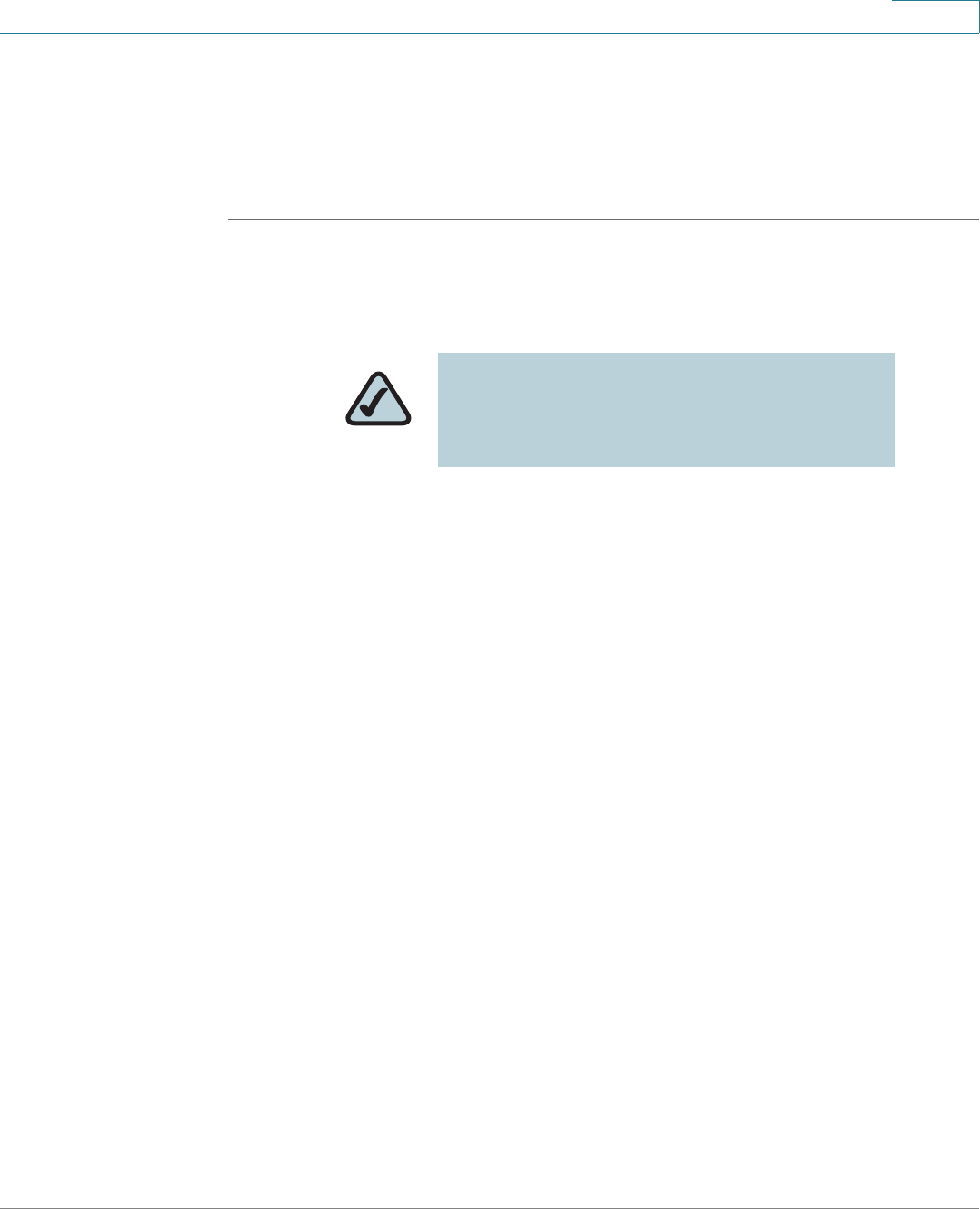
Getting Started
Using Phone Hardware and Accessories
Cisco Small Business Pro SPA IP Phone 525G (SIP) User Guide 22
1
STEP 4 Scroll to PIN and enter the PIN for your Bluetooth headset.
STEP 5 Scroll to Connect Automatically and press the Right Arrow key to turn to
On
.
STEP 6 Press Connect. The profile screen displays and a check mark appears next to the
headset if the connection was successful.
Using a Headset with Your IP Phone
•To use a wired headset, press the Headset button on your phone and dial
the number to place a call, or press the headset button to answer a ringing
call.
•To use a non-Bluetooth wireless headset (such as Jabra or Plantronics), lift
the receiver off hook before speaking or listening through the headset.
•To use a Bluetooth headset, make sure your headset is powered on. Press
the Headset button on your phone (or, if supported, press the Answer
button on your Bluetooth headset twice) and dial the number to place a call.
Press the Answer button on your Bluetooth headset to answer a ringing call.
See the user documentation for your Bluetooth headset for more
information.
Switching Between the Handset/Headset/Speakerphone
During a Call
Any of these audio devices can be used during a call. Only one device can be
used at a time. The handset can be on the hook when using the speakerphone or
headset function.
NOTE: Steps to use your headset with the
SPA IP Phone may vary. Consult the user
documentation for your headset for more
information.

Getting Started
Using Phone Hardware and Accessories
Cisco Small Business Pro SPA IP Phone 525G (SIP) User Guide 23
1
To switch from the handset to the speakerphone, press the Speakerphone button
and place the handset back on the hook.
To switch from the speakerphone to a headset, press the Headset button.
To switch from the speakerphone to the handset, pick up the handset.
To switch from the headset to the speakerphone, press the Speakerphone button.

2
Cisco Small Business Pro SPA IP Phone 525G (SIP) User Guide 24
Installing Your Phone
This chapter describes how to install and connect your Cisco SPA525G IP Phone.
It contains the following sections:
•Before You Begin, page 25
•Connecting the Handset, page 25
•(Optional) Attaching the Desk Stand, page 27
•(Optional) Mounting the Phone to the Wall, page 28
•Connecting Your Phone’s Power, page 30
•Connecting Your Phone to the Computer Network, page 31
•Verifying Phone Startup, page 39
•Upgrading Your Phone’s Firmware, page 39
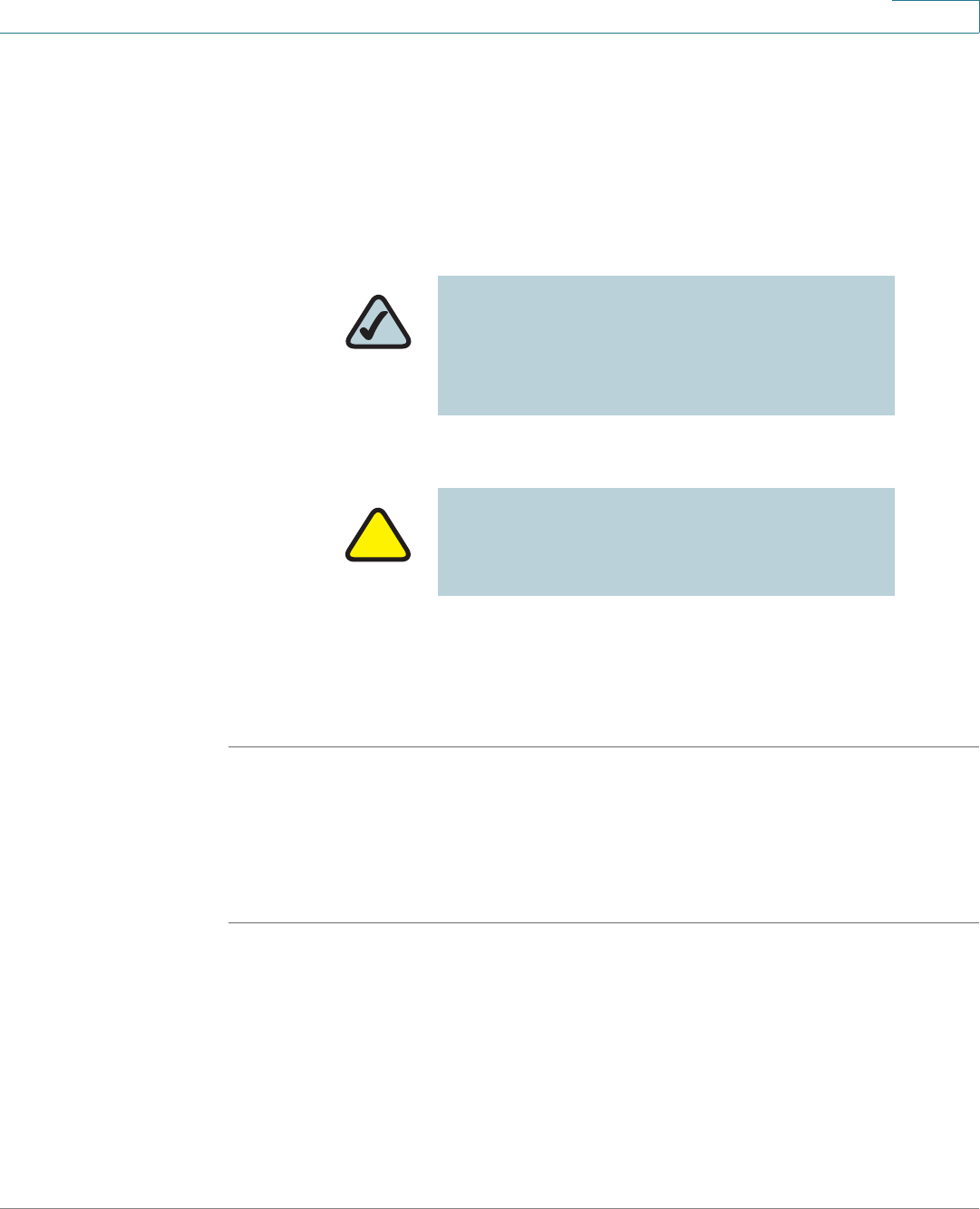
Installing Your Phone
Before You Begin
Cisco Small Business Pro SPA IP Phone 525G (SIP) User Guide 25
2
Before You Begin
Before you install and connect your phone, verify with your System Administrator
(if applicable) that the network is ready for the phone, read the safety notices, and
make sure you have all the phone parts and documentation available.
Connecting the Handset
STEP 1 Find the longer end of the coiled phone cord. Insert it into the back of the phone
base in the slot marked with a phone symbol. This port is labeled #5 on the Cisco
SPA525G IP Phone Connections graphic.
STEP 2 Insert the short end of the handset cord into the jack at the bottom of the handset
(not shown).
NOTE: The RJ-11 port marked “AUX” is
reserved for connection with the SPA932
Attendant Console that works with the
SPA525G. It is not for use as a telephone line
port.
!
CAUTION: Do not plug a telephone line cord
into the port marked “AUX.”
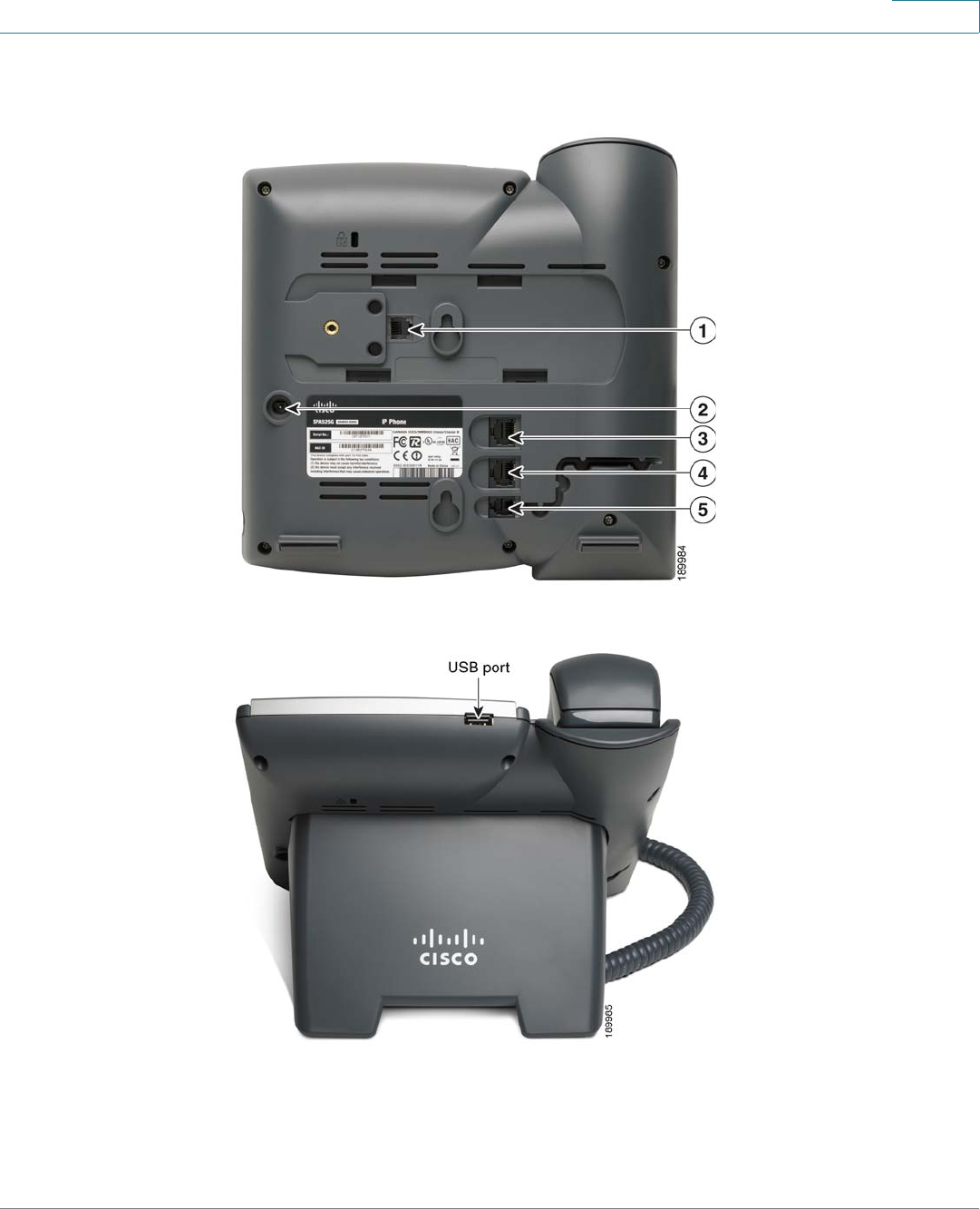
Installing Your Phone
Connecting the Handset
Cisco Small Business Pro SPA IP Phone 525G (SIP) User Guide 26
2
Figure 1 Cisco SPA525G IP Phone Connections
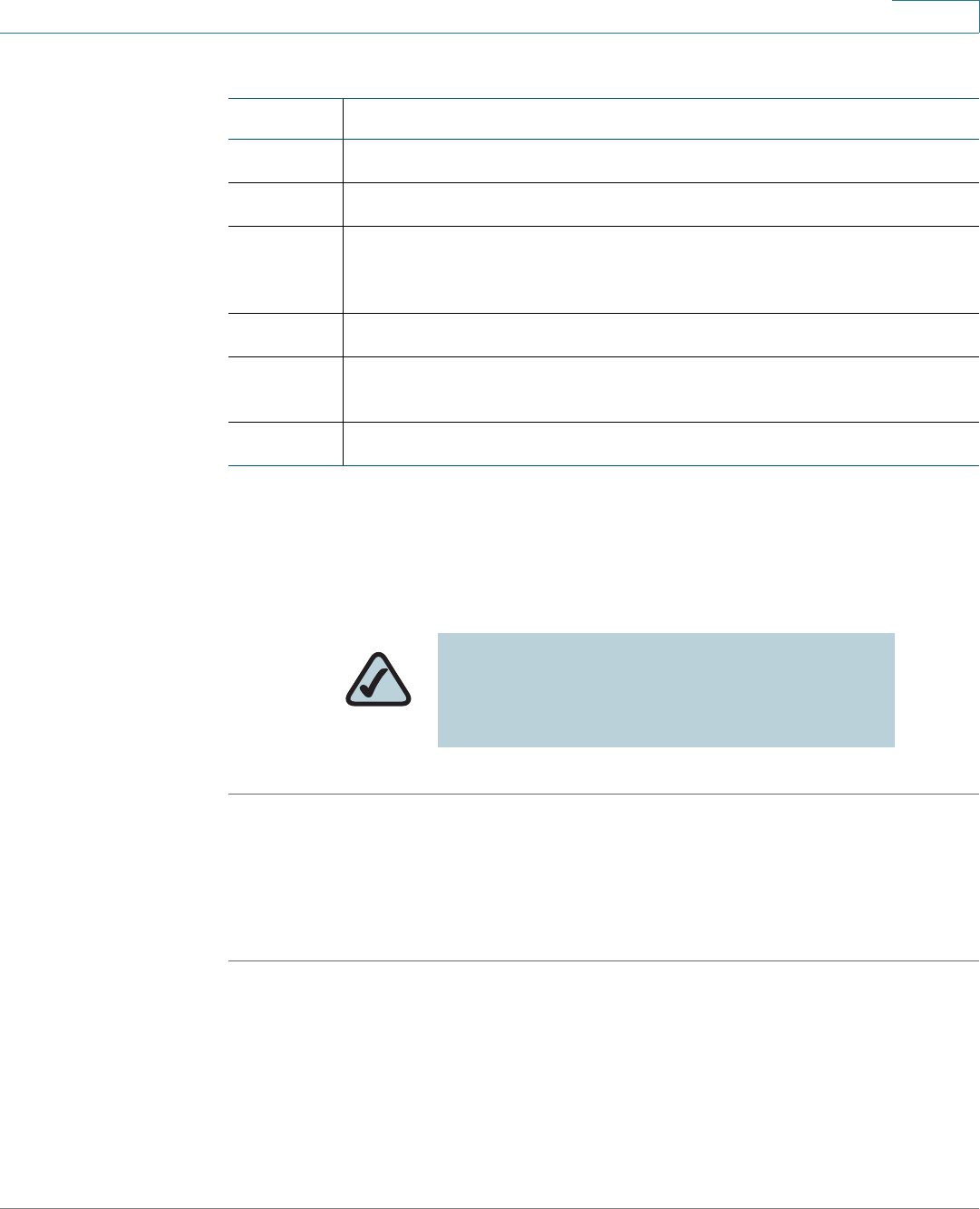
Installing Your Phone
(Optional) Attaching the Desk Stand
Cisco Small Business Pro SPA IP Phone 525G (SIP) User Guide 27
2
(Optional) Attaching the Desk Stand
STEP 1 Line up the tabs on the desk stand with the slots on the back of the phone.
STEP 2 Slide the bottom tabs into the slots
STEP 3 Lightly press down on the top of the desk stand. It should easily slide into the top
slots. Do not force.
Number Component
1 Auxiliary port. Only for use with the SPA932 attendant console.
2 Power port. Insert the power adapter plug into this port.
3 Additional Ethernet port. Connect an Ethernet cable to this port to provide
network connectivity to a PC. (This port cannot be used when the phone
is connected to the network via the built-in Wireless-G client.)
4 Switch (Ethernet) port. Connect the network cable to this port.
5 Phone cord slot. Insert one end of the phone cord into this slot and the
other into the jack at the bottom of the phone handset.
6 USB port. For use with an external USB memory device (optional).
NOTE: Do not attach the desk stand if you
want to mount the phone to the wall. If you are
attaching a SPA932 attendant console attach
the console before attaching the desk stand.
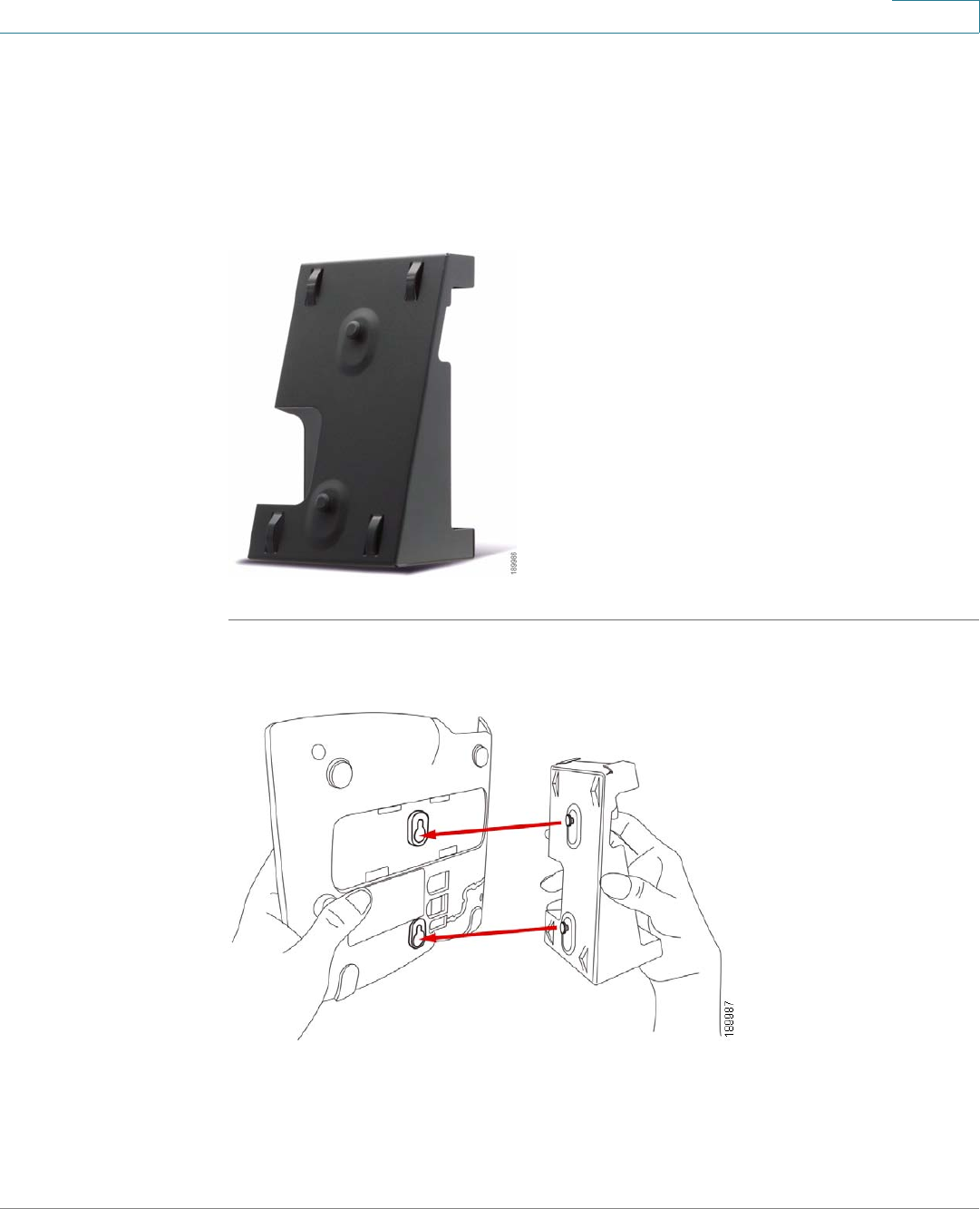
Installing Your Phone
(Optional) Mounting the Phone to the Wall
Cisco Small Business Pro SPA IP Phone 525G (SIP) User Guide 28
2
(Optional) Mounting the Phone to the Wall
To mount the phone to the wall, you must purchase the MB100 wall mount bracket
kit.
Figure 2 MB100 Wall Mount Kit
STEP 1 To attach the Mounting Bracket (MB), align the two cleats on the MB with the holes
in the phone’s base.
STEP 2 Orient the MB such that the phone’s Ethernet and handset ports are accessible
after installation.
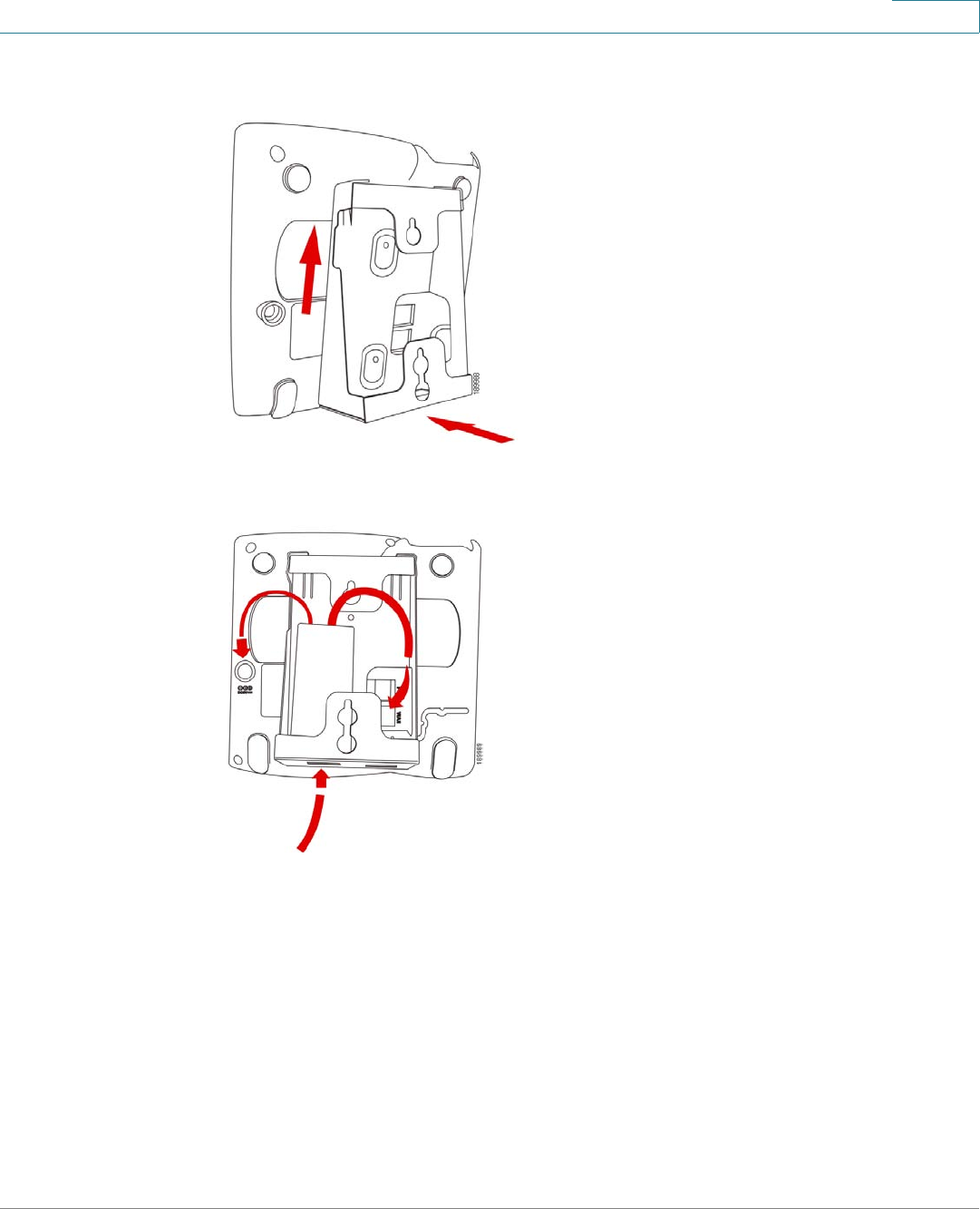
Installing Your Phone
(Optional) Mounting the Phone to the Wall
Cisco Small Business Pro SPA IP Phone 525G (SIP) User Guide 29
2
STEP 3 Push the MB onto the phone’s base. Slide the MB upwards to lock it in place.
STEP 4 Plug in the Ethernet and power cables.
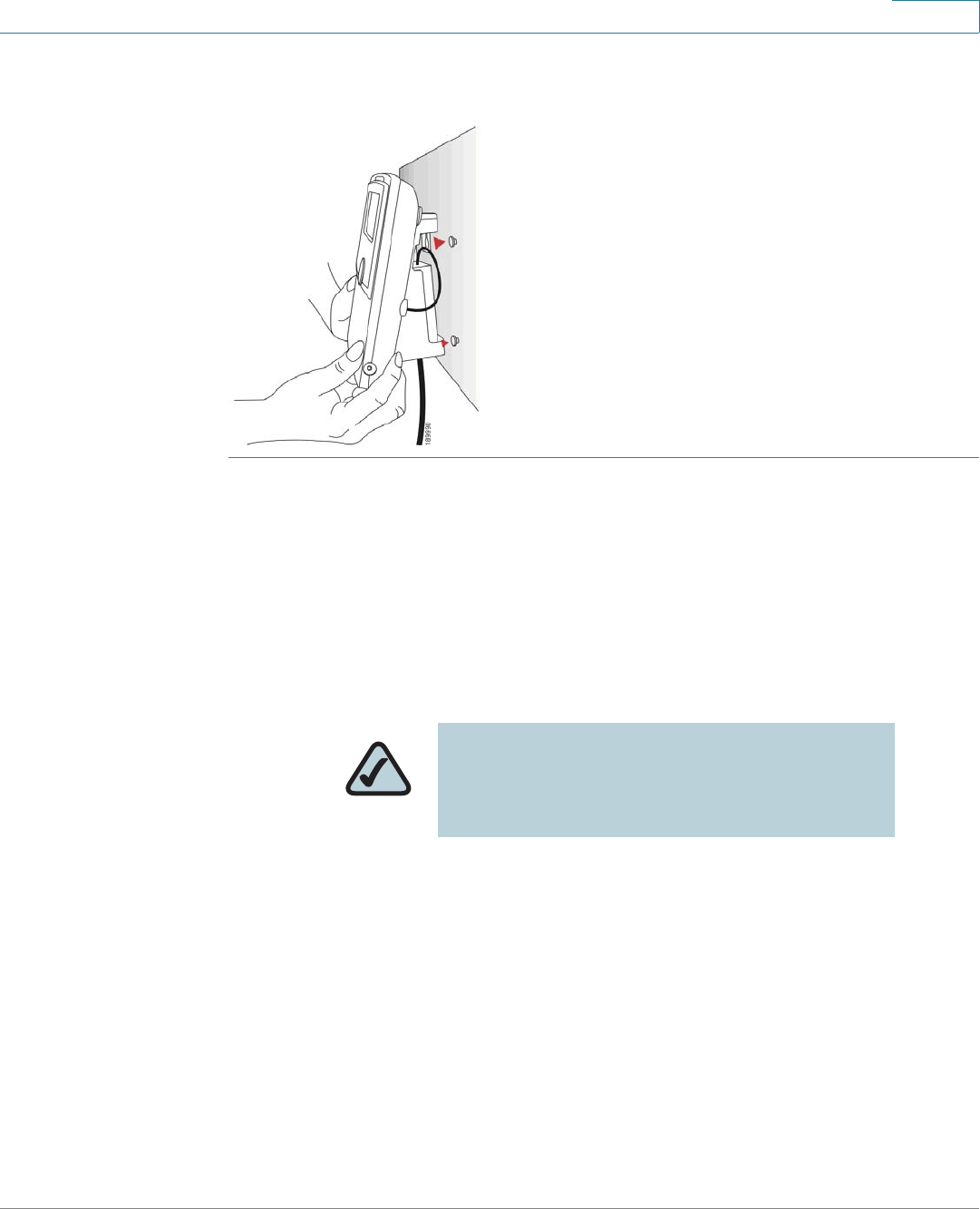
Installing Your Phone
Connecting Your Phone’s Power
Cisco Small Business Pro SPA IP Phone 525G (SIP) User Guide 30
2
STEP 5 Hang onto screws mounted in the wall.
Connecting Your Phone’s Power
If you are using an external power source, plug it into the building’s power source,
and plug the power supply into the phone base. See Figure 1 on page 26, item #2.
If you are using Power over Ethernet (PoE) to power the phone, the phone will
receive power when you connect an Ethernet cable from the phone’s WAN port to
a switch in your network that provides PoE. See the ”Connecting Your Phone to the
Wired Network” section on page 31.
NOTE: The SPA525G does not ship with a
power supply. If you are not using Power over
Ethernet (PoE), you must order the PA-100
power supply separately from Cisco.
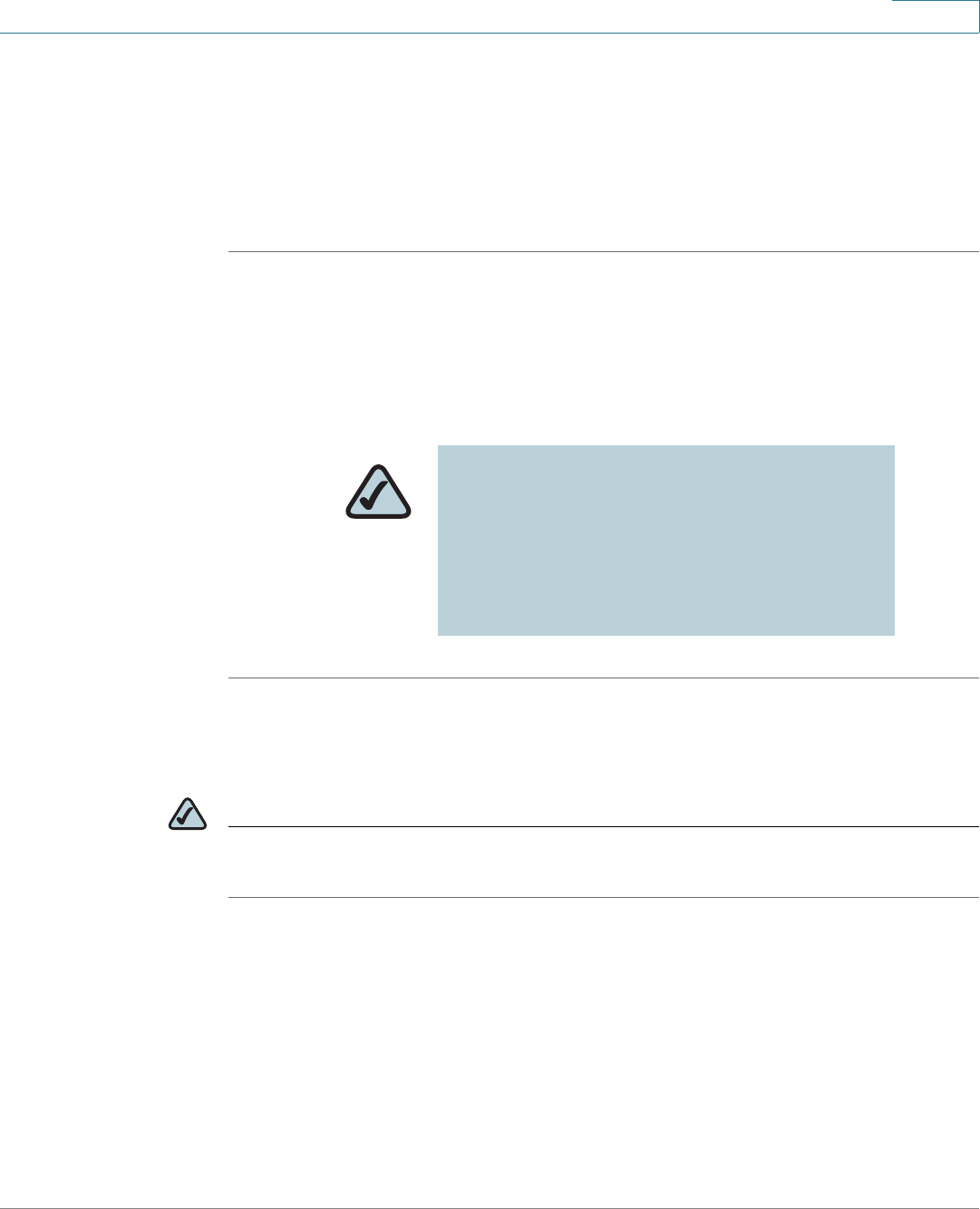
Installing Your Phone
Connecting Your Phone to the Computer Network
Cisco Small Business Pro SPA IP Phone 525G (SIP) User Guide 31
2
Connecting Your Phone to the Computer Network
Connecting Your Phone to the Wired Network
You connect your phone to the local network by using an Ethernet cable:
STEP 1 Plug the Ethernet cable into the back of the base station into the slot marked “SW.”
This port is labeled #4 on Figure 1 on page 26.
STEP 2 Plug the other end of the Ethernet cable into the appropriate device on your
network, such as a network switch.
Connecting Your Phone to the Wireless Network
NOTE The PC port is not supported in wireless operation. The PC port is only supported
in a wired operation.
NOTE: The SPA525G provides a second
Ethernet port. You can connect a PC to this port
to provide network access to the PC. This port
is labeled #3 in the Cisco SPA525G IP Phone
Connections graphic. This port cannot be used
when the phone is connected to the network
via the built-in Wireless-G client.

Installing Your Phone
Connecting Your Phone to the Computer Network
Cisco Small Business Pro SPA IP Phone 525G (SIP) User Guide 32
2
The Cisco SPA 525G phone supports a direct connection to the wireless network.
Before setting up the wireless network, you need to know the wireless security
type for your router. The SPA525G works with the following security types:
•WEP—Wired Equivalent Privacy. With this type of security, you need to
enter a 64 or 128-bit key on the phone (or a more easily remembered
passphrase to generate the key). The phone then authenticates with your
router to provide a secure connection.
•WPA—Wi-Fi Protected Access. The SPA525G supports WPA PSK, WPA2
PSK, WPA Enterprise, and WPA2 Enterprise. With this type of security, you
will at the very minimum be required to enter a password on the phone. The
phone then authenticates with your router to provide a secure connection.
Determining Your Wireless Router Security Type
If you do not know your wireless router security type, you need to log in to the
router interface to get this information. The steps below are written for a Linksys
router, but procedures for other routers should be similar.
STEP 1 Log in to your wireless router’s web interface using a web browser. Your computer
must be connected to your wireless network. Enter the IP address of the wireless
router in the browser toolbar.
STEP 2 If required, enter the user name and password. (By default, Linksys routers
typically use “admin” for the user name and “admin” for the password.)
STEP 3 View the Wireless tab or screen. Note the network name (SSID) and the type of
security (WEP, WPA Personal, or WPA2 Personal).
If your router is using WEP, note the following:
•WEP encryption: 64 bit or 128 bit. You need to choose this later.
•Default transmit key, or TX key: The default key (of the 4) that the router
transmits to authenticate. This value will be 1, 2, 3, or 4.
•Passphrase and keys: You choose one of two methods to enter the WEP
key. You either directly enter the WEP key, or enter a more simple
passphrase to generate the WEP key.
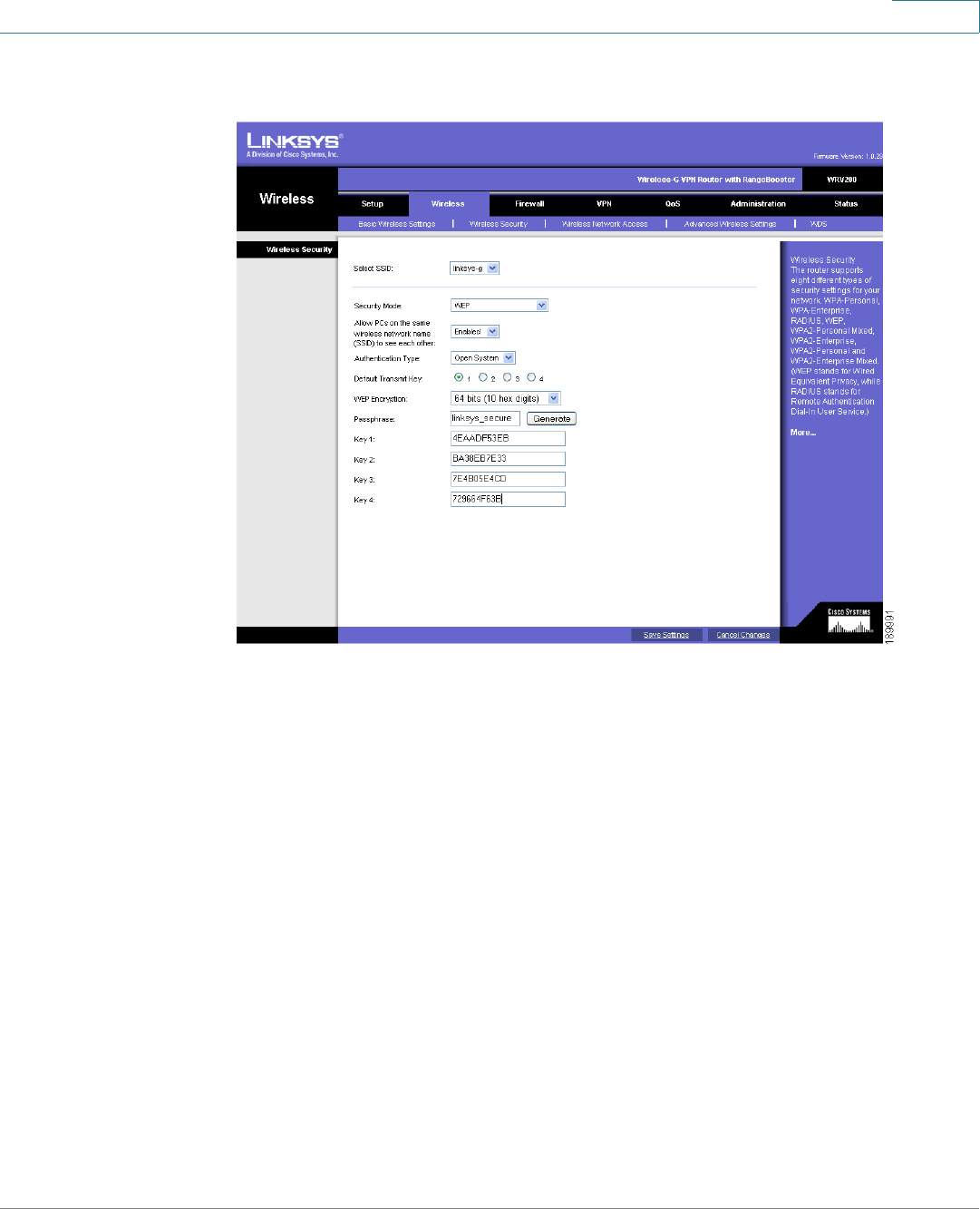
Installing Your Phone
Connecting Your Phone to the Computer Network
Cisco Small Business Pro SPA IP Phone 525G (SIP) User Guide 33
2
The following example shows WEP information for a Linksys WRV200 router:
If your router is using WPA, note the WPA shared key, or passphrase that you need
to enter later.
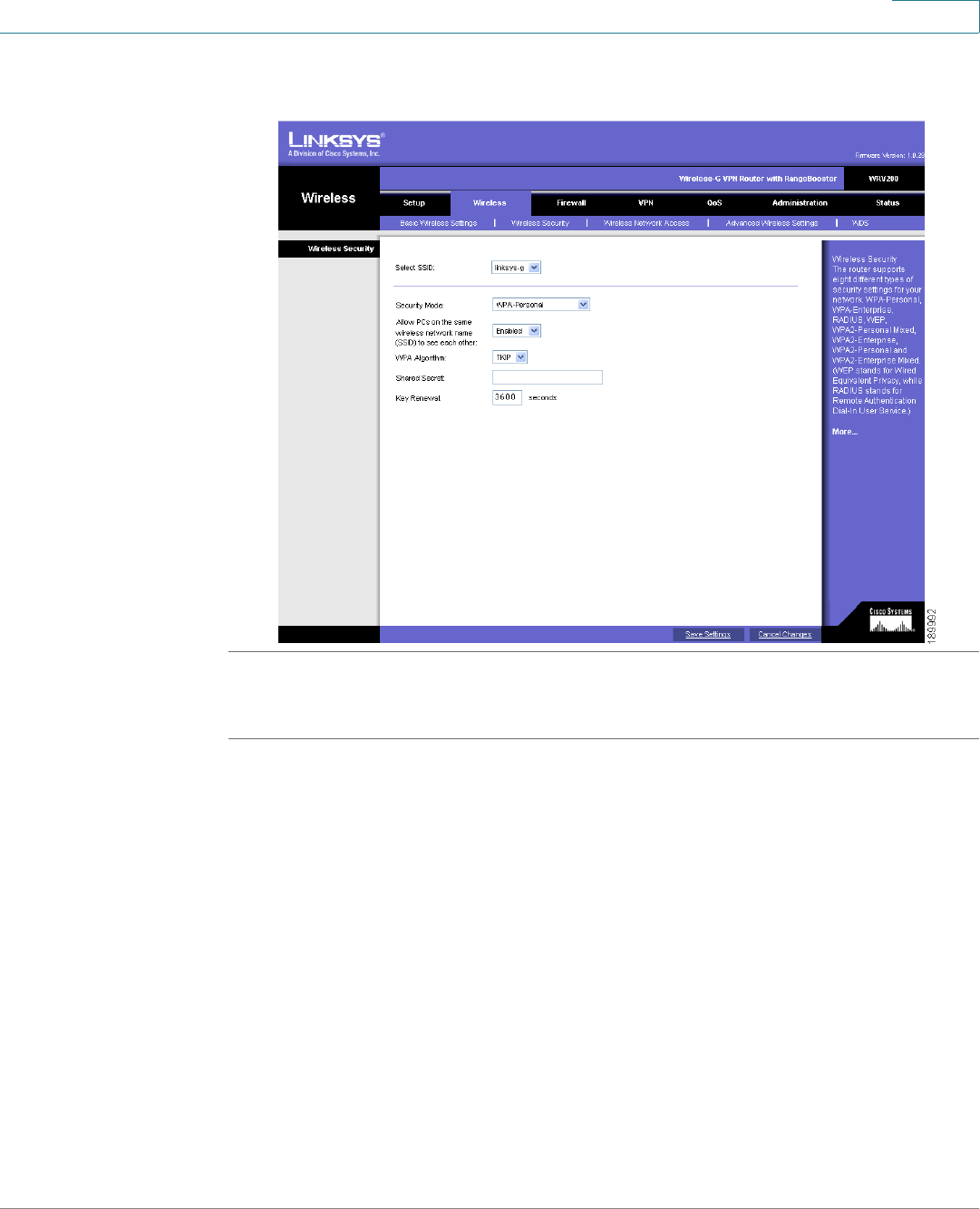
Installing Your Phone
Connecting Your Phone to the Computer Network
Cisco Small Business Pro SPA IP Phone 525G (SIP) User Guide 34
2
The following example shows WPA information for a Linksys WRT160N router:
To set up the SPA525G wireless connection:
STEP 1 If you have plugged in an Ethernet cable to connect the phone to the wired
network, remove it and reboot the phone. If an Ethernet connection is present on
the phone, it is used instead of the Wi-Fi connection.
STEP 2 Press the Setup button on your phone.
STEP 3 Scroll to Network Configuration and press Select.
STEP 4 In the Wi-Fi field, press the Left or Right Arrow key to turn Wi-Fi
On
. Press the Save
softkey.

Installing Your Phone
Connecting Your Phone to the Computer Network
Cisco Small Business Pro SPA IP Phone 525G (SIP) User Guide 35
2
STEP 5 Scroll to Wi-Fi Configuration and press the Right Arrow key. Choose one of the
following options:
•Wireless Profile—Use this option to add a new wireless profile (either
manually or by scanning for available networks), edit an existing wireless
profile, or connect to a previously configured network. See Manually Adding
a Wireless Profile on the SPA525G, page 36.
•Wi-Fi Protected Setup—If your wireless router supports Wi-Fi Protected
Setup, use this method to set up your wireless connection. See Using Wi-Fi
Protected Setup with the SPA525G, page 35.
Using Wi-Fi Protected Setup with the SPA525G
STEP 1 In the Wireless Configuration screen, select
Wi-Fi Protected Setup
.
STEP 2 Choose one of the following options:
Push Button Configuration:
a. Press the WPS button on your router.
b. On your phone, with
Push Button Configuration
highlighted, press Select. Your
phone may reboot before the Wi-Fi connection is working.
PIN Configuration
a. After selecting PIN Configuration on your phone, note the PIN displayed.
b. Connect to your router’s web interface using a web browser. Your computer
must be connected to your wireless network. Enter the IP address of the
wireless router in the browser address bar.
c. If required, enter the user name and password. (By default, Linksys routers
typically use “admin” for the user name and “admin” for the password.)
d. View the Wireless tab or screen. Locate the Wireless Protected Setup
configuration menu.
If your router has a WPS button, you can use Wi-Fi Protected
Setup to add a new wireless network profile.

Installing Your Phone
Connecting Your Phone to the Computer Network
Cisco Small Business Pro SPA IP Phone 525G (SIP) User Guide 36
2
e. Enter the PIN into the field that allows you to setup wireless devices using a
PIN.
f. Save your changes.
g. On the SPA525G, with PIN Configuration highlighted, press Select. To a d d t h e
connection as a profile, press OK. Your phone may reboot before the Wi-Fi
connection is working.
Manually Adding a Wireless Profile on the SPA525G
To add a new wireless network profile:
STEP 1 In the Network Configuration screen, ensure Wi-Fi is enabled.
STEP 2 Scroll to
Wi-Fi Configuration
. Press the Right Arrow key to enter the Wi-Fi
Configuration screen.
STEP 3 Select Wireless Profile. Any previously configured wireless profiles are displayed.
STEP 4 Do one of the following:
•Scan for available networks. See Scanning for Available Networks, page 36.
•Manually add the network. See Manually Adding a Network, page 37.
Scanning for Available Networks
NOTE If your router has SSID (router name) broadcast disabled, it may not appear in the
list of networks. In that case, you need to manually add it (see Manually Adding a
Network, page 37).
STEP 1 In the Wireless Profile screen, press Scan.
STEP 2 In the list of available networks, scroll to the desired network and click Add to
select the highlighted network.

Installing Your Phone
Connecting Your Phone to the Computer Network
Cisco Small Business Pro SPA IP Phone 525G (SIP) User Guide 37
2
STEP 3 (Optional) Press the Right Arrow key under Security Mode to set the security
options:
•WEP—Wired Equivalent Privacy: You must enter the Default Transmit Key,
Key Type and Length, and the keys.
•WPA PSK or WPA2 PSK: You must enter the Cipher Type (TKIP or AES
CCMP) and the shared key.
•WPA/WPA2 Enterprise: This type of authentication requires some
advanced expertise because it involves setting up a radius server for
authentication and, in some cases, creation of certificates for both the
radius server and the phone. See
You must enter the Cipher Type (TKIP or AES CCMP) and the EAP Type:
-TTLS—Enter the anonymous ID, choose whether the phone should
check for the server certificate, choose the TTLS Inner Protocol
(MSCHV2, MSCHAP, PAP, CHAP, or MD5), and enter the User ID and
password.
-LEAP—Enter the User ID and password.
-TLS—Enter the User ID, choose whether the phone should check for the
server certificate, enter the User ID, and configure the Root certificate
and User certificate (see the ”Uploading Security Certificates to the
Phone” section on page 38).
STEP 4 To save as a wireless profile, press Save.
Manually Adding a Network
STEP 1 From the Wireless Profile screen, press Option and select Add New to manually
add the network.
STEP 2 (Optional) Press the Right Arrow key under Security Mode to set the security
options:
•WEP—Wired Equivalent Privacy: You must enter the Default Transmit Key,
Key Type and Length, and the keys.
•WPA PSK or WPA2 PSK: You must enter the Cipher Type (TKIP or AES
CCMP) and the shared key.

Installing Your Phone
Connecting Your Phone to the Computer Network
Cisco Small Business Pro SPA IP Phone 525G (SIP) User Guide 38
2
•WPA/WPA2 Enterprise: You must enter the Cipher Type (TKIP or AES
CCMP) and the EAP Type:
-TTLS: Enter the anonymous ID, choose whether the phone should check
for the server certificate, choose the TTLS Inner Protocol (MSCHV2,
MSCHAP, PAP, CHAP, or MD5), and enter the User ID and password.
-LEAP: Enter the User ID and password.
-TLS: Enter the User ID, choose whether the phone should check for the
server certificate, enter the User ID, and configure the Root certificate
and User certificate (see the ”Uploading Security Certificates to the
Phone” section on page 38).
STEP 3 To save as a wireless profile, press Save.
Uploading Security Certificates to the Phone
If you are using some types of wireless security (for example, WPA2 Enterprise),
you will need to upload security certificates to the phone. Certificates must be in
the following format:
•Root certificate: DER encoded binary x.509 (CER)
•User certificate: Personal Information Exchange (PKCS#12(.PFX))
STEP 1 Connect a USB storage device to your PC.
STEP 2 Create a directory named “ca” on the USB device and copy the certificate files into
that directory.
STEP 3 Remove the USB device from your PC and insert it into the USB slot on the
SPA525G.
STEP 4 After creating a wireless profile, in the Profile screen, press the Right Arrow key
under Security Mode to set the security options (WPA Enterprise or WPA2
Enterprise).
STEP 5 Scroll to Root Certificate and press the Right Arrow key. All files in the “ca” folder
are displayed.

Installing Your Phone
Verifying Phone Startup
Cisco Small Business Pro SPA IP Phone 525G (SIP) User Guide 39
2
STEP 6 Use the Up Arrow or Down Arrow key to choose the certificate you want to install
(for example, the root certificate). Press the Select softkey.
STEP 7 Press Save to save the profile.
Verifying Phone Startup
After receiving power and network connectivity, the phone executes a boot-up
sequence. During this sequence, the display shows the Cisco logo. All of the lights
on the phone will flash. After the sequence, which should take about five seconds,
the phone will display the standard menu for the phone. The date, name and
number of the phone appear on the top line of the LCD screen. At the bottom of the
LCD screen, softkeys appear over their associated soft buttons.
If the phone does not display this screen, confirm your installation and
connections. If these are correct, try unplugging the phone and plugging it back in
again. If you still don’t see the display, then contact your Phone Administrator or
Internet Telephony Service Provider (ITSP).
Upgrading Your Phone’s Firmware
Your phone ships with pre-installed firmware. However, later firmware versions
may be available that add features and fix problems with your phone. You may
need to upgrade your phone to the latest firmware for ideal performance.
!
IMPORTANT: If you are using your phone with
an Internet Telephony Service Provider’s
system, do not upgrade your phone’s firmware
without consulting your service provider. Yo ur
provider may automatically upgrade your
phones without any action on your part
necessary.

Installing Your Phone
Upgrading Your Phone’s Firmware
Cisco Small Business Pro SPA IP Phone 525G (SIP) User Guide 40
2
There are two ways to upgrade your phone’s firmware:
•Download the firmware to your PC and log in to the web interface to run the
upgrade procedure. See the ”Upgrading Firmware” section on page 91.
•Upgrade using the Cisco SPA9000 Voice System Setup Wizard (if your
phone is part of a Cisco SPA9000 Voice System network). See the
Cisco
SPA9000 Voice System Setup Wizard User Guide
.

3
Cisco Small Business Pro SPA IP Phone 525G (SIP) User Guide 41
Using Basic Phone Functions
This chapter describes how to use the basic functions of your SPA525G IP phone.
It includes the following sections:
•Placing or Answering a Call, page 42
•Adjusting Call Volume and Muting, page 43
•Putting a Call on Hold, page 43
•Resuming a Call, page 44
•Ending a Call, page 44
•Transferring Calls, page 44
•Redialing, page 45
•Viewing and Returning Missed Calls, page 46
•Turning the Missed Calls Shortcut On and Off, page 47
•Forwarding Calls, page 47
•Setting Do Not Disturb, page 49
•Picking Up a Call, page 51
•Parking a Call, page 52
•Placing a Three-Way Conference Call, page 53
•Using the Phone Directories, page 54
•Using the Call History Lists, page 58
•Setting or Changing a Phone Password, page 60
•Accessing Voicemail, page 61

Using Basic Phone Functions
Placing or Answering a Call
Cisco Small Business Pro SPA IP Phone 525G (SIP) User Guide 42
3
Placing or Answering a Call
To place or answer a call, do one of these:
•Pick up the receiver.
•Press the Speaker button.
•Press the Headset button.
•Press a green line button (to place a call) or a red flashing line button or the
Answer softkey (to answer a call).
If you are on a call and another call comes in, choose one of the following options:
•Press the Answer softkey.
•Press the flashing red line button.
The call in progress is put on hold and the incoming call is answered.
To return to the first call, select it using the Up Arrow or Down Arrow key and press
the Resume softkey.
NOTE: You may have to dial a number or
numbers to reach an outside line. Ask your
system administrator.

Using Basic Phone Functions
Adjusting Call Volume and Muting
Cisco Small Business Pro SPA IP Phone 525G (SIP) User Guide 43
3
Using Dial Assistance
If dial assistance is enabled, when placing calls, you’ll see a list of closely-matched
phone numbers on the screen after you begin dialing. If you want to choose one of
these numbers:
STEP 1 Use the navigation button to scroll down and highlight a phone number on the LCD
screen.
STEP 2 Press the Select button or Dial to complete the call.
See “Enabling Dial Assistance,” on page 65 for more information on enabling this
feature.
Adjusting Call Volume and Muting
Adjusting Call Volume
To adjust the volume while you are on a call, press + on the Volume button to
increase the volume, or press - to decrease the volume. Press Save.
Pressing the Volume button while not on a call adjusts the volume of the phone’s
ringer.
Using Mute
To mute the phone microphone, speaker, or headset microphone, press the Mute
button on the phone. The button lights red. Press the Mute button again to unmute.
Putting a Call on Hold
To put a call on hold, press the Hold button. A series of beeps indicates the call is
on hold.

Using Basic Phone Functions
Resuming a Call
Cisco Small Business Pro SPA IP Phone 525G (SIP) User Guide 44
3
Resuming a Call
To resume the call, press the flashing red line button for the call. If you have
multiple calls, all calls are put on hold except the active call.
Ending a Call
To end a call:
•If you are using the handset, hang up.
•If you are using the speakerphone, press the Speaker button.
•If you are using the headset, either press the Headset button (wired) or replace
the receiver (wireless).
Transferring Calls
You can perform two types of transfers:
•Attended—You call the person to whom you are transferring the call and
speak to them before transferring the call.
•Blind—You transfer the call without speaking to the other party to which you
are transferring the call.
Performing an Attended Transfer
STEP 1 During an active call, or a call on hold, press Transfer.
STEP 2 Either:
•Enter the number to which you want to transfer the call; or
•Press Directory and either choose a number from the personal directory.
STEP 3 Press Dial or wait a few seconds. The call is placed on hold and a new line is
opened to dial the number.

Using Basic Phone Functions
Redialing
Cisco Small Business Pro SPA IP Phone 525G (SIP) User Guide 45
3
STEP 4 Do one of the following:
•To transfer the call without waiting for the other person to answer, press
Transfer after the call begins to ring and hang up. If you hang up before the
second call rings, the transfer fails and the first call is disconnected. If you
misdial, press the second line button again to receive a dial tone.
•To transfer after speaking privately to the other person, press Transfer at
any time during the conversation.
Performing an Unattended (Blind) Transfer
STEP 1 During an active call, press BXfer.
STEP 2 Enter the number to which you want to transfer the call and press Dial. The call is
transferred with no further action required on your part.
Redialing
To redial a number:
STEP 1 Press the Redial button and select the desired number.
STEP 2 (Optional) Press EditDial to select a number and modify it (for example, to add an
area code).
STEP 3 Lift the handset or press Dial to select a number. The number is automatically
dialed.

Using Basic Phone Functions
Viewing and Returning Missed Calls
Cisco Small Business Pro SPA IP Phone 525G (SIP) User Guide 46
3
Viewing and Returning Missed Calls
The LCD screen on your IP phone notifies you if a call came in that was
unanswered. (You can also turn off this feature - see the ”Turning the Missed Calls
Shortcut On and Off” section on page 47.)
Returning a Missed Call
To return a missed call:
•If the LCD screen shows a missed call, press the Call Rtn button to return the
call.
•If the LCD screen does not show a missed call, you can return a call from the
Missed Call list. See ”Viewing a List of Missed Calls” on page 46. Choose the
call you want to return and press Dial.
Viewing a List of Missed Calls
To view a list of all missed calls:
•If the LCD screen shows a missed call, press the Missed softkey to view a list
of missed calls.
•If the LCD screen does not show a missed call:
a. Press the Setup button.
b. Scroll to Call History and press Select.
NOTE: If the call was from a long distance
number, you may have to edit the call before
returning it. Press the Edit button to edit the call
and use the softkey buttons and keypad to edit
the number.

Using Basic Phone Functions
Turning the Missed Calls Shortcut On and Off
Cisco Small Business Pro SPA IP Phone 525G (SIP) User Guide 47
3
c. Scroll to Missed Calls and press Select. You can do one of the following:
•Press Dial to dial the number that called you.
•Press EditDial to edit the number before calling it, then press Dial.
•Press the Option softkey and choose one of the following:
-Delete Entry—Delete the entry from the Missed Calls list.
-Delete List—Delete all entries from the Missed Calls list.
-Add to Address Book—Add the entry to your personal address book.
Turning the Missed Calls Shortcut On and Off
This option controls the Missed Call notification that appears on your LCD screen
when you miss a call. To access this option:
STEP 1 Press the Setup button.
STEP 2 Scroll to User Preferences and press Select.
STEP 3 Select Call Preferences.
STEP 4 Scroll to Miss Call Shortcut.
STEP 5 Press the Right Arrow key to turn the feature on and press the Save softkey.
Forwarding Calls
You can forward all calls, forward calls when the phone is busy or forward calls
when there is no answer. You can also set call forwarding options from your PC
using the IP Phone Web Interface; see the ”Configuring Call Forwarding” section
on page 86.
To forward calls:
STEP 1 Press the Setup button.
STEP 2 Scroll to User Preferences and press Select.